Tour Operations Management: A Comprehensive Guide to the Industry
VerifiedAdded on 2024/06/11
|23
|5582
|476
AI Summary
This report provides a comprehensive overview of the tour operations management industry, exploring current trends, development stages, contracting methods, pricing strategies, brochure design, distribution channels, and strategic and tactical decision-making. It delves into the impact of recent developments like technology advancements and dynamic packaging on the industry. The report also examines the various types of tour operators and their unique approaches to managing operations. By analyzing real-world examples and case studies, this report offers valuable insights for students and professionals seeking to understand the complexities of the tour operations management industry.
Contribute Materials
Your contribution can guide someone’s learning journey. Share your
documents today.
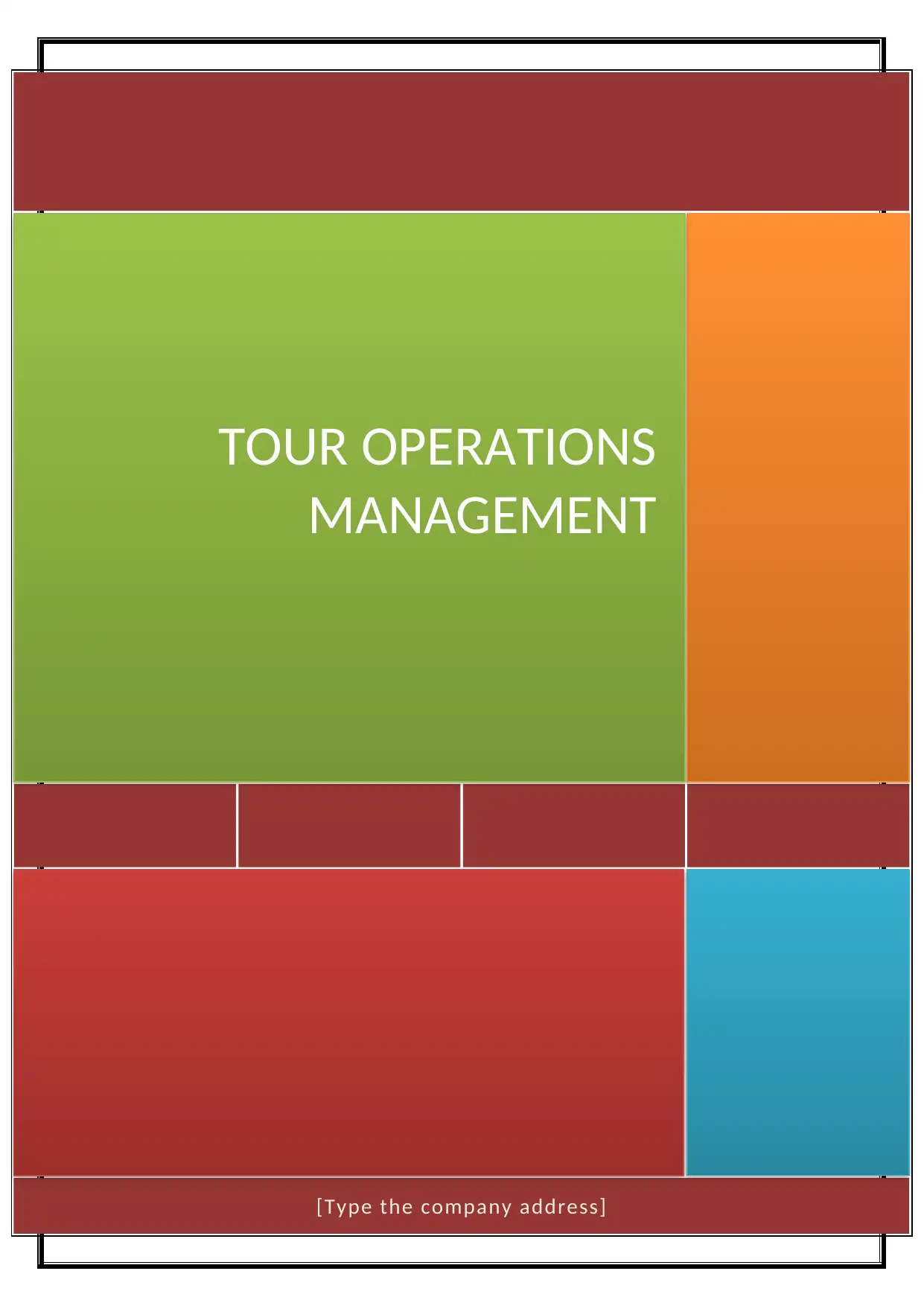
[Type the company address]
TOUR OPERATIONS
MANAGEMENT
TOUR OPERATIONS
MANAGEMENT
Secure Best Marks with AI Grader
Need help grading? Try our AI Grader for instant feedback on your assignments.
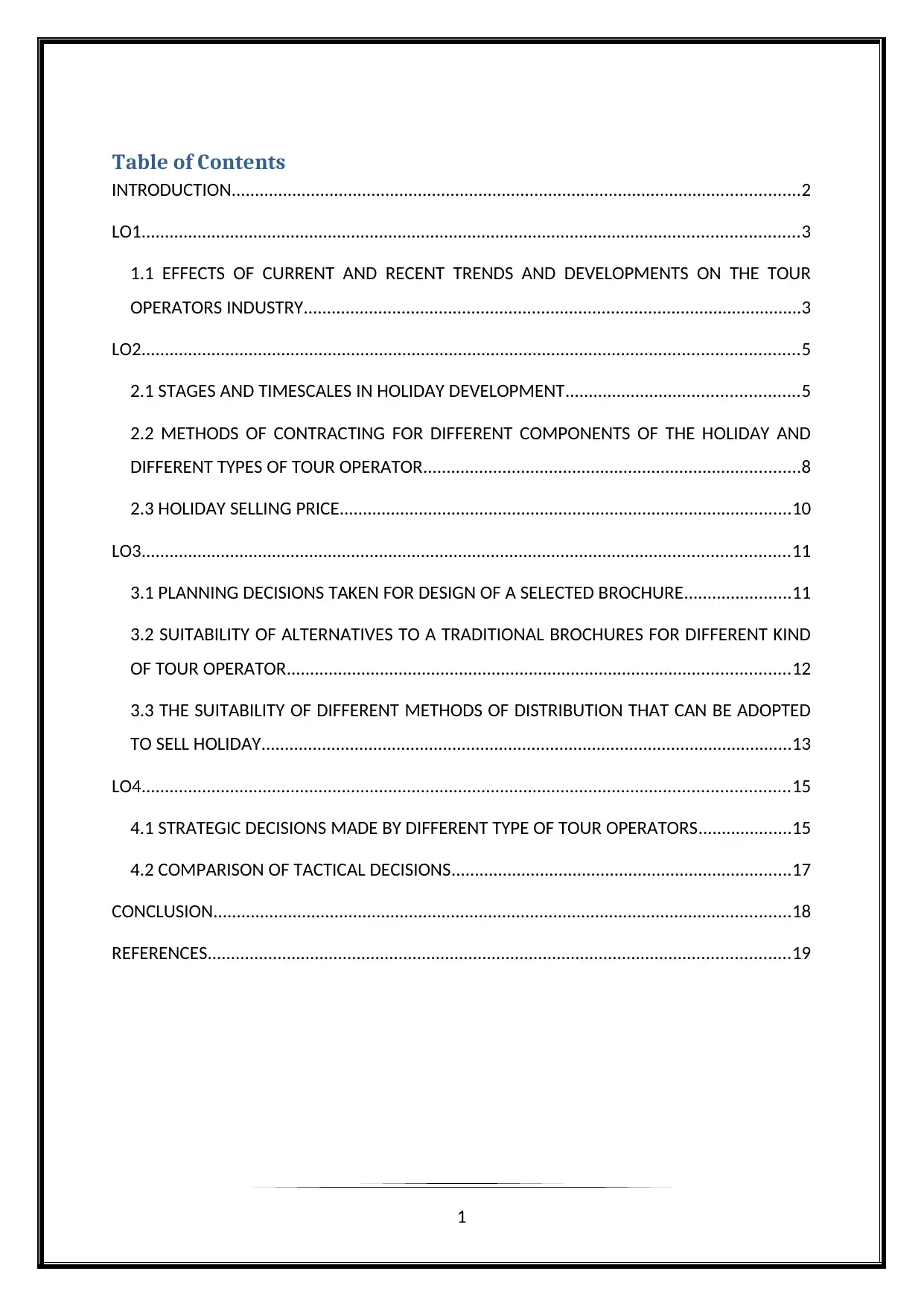
Table of Contents
INTRODUCTION..........................................................................................................................2
LO1.............................................................................................................................................3
1.1 EFFECTS OF CURRENT AND RECENT TRENDS AND DEVELOPMENTS ON THE TOUR
OPERATORS INDUSTRY...........................................................................................................3
LO2.............................................................................................................................................5
2.1 STAGES AND TIMESCALES IN HOLIDAY DEVELOPMENT..................................................5
2.2 METHODS OF CONTRACTING FOR DIFFERENT COMPONENTS OF THE HOLIDAY AND
DIFFERENT TYPES OF TOUR OPERATOR.................................................................................8
2.3 HOLIDAY SELLING PRICE.................................................................................................10
LO3...........................................................................................................................................11
3.1 PLANNING DECISIONS TAKEN FOR DESIGN OF A SELECTED BROCHURE.......................11
3.2 SUITABILITY OF ALTERNATIVES TO A TRADITIONAL BROCHURES FOR DIFFERENT KIND
OF TOUR OPERATOR............................................................................................................12
3.3 THE SUITABILITY OF DIFFERENT METHODS OF DISTRIBUTION THAT CAN BE ADOPTED
TO SELL HOLIDAY..................................................................................................................13
LO4...........................................................................................................................................15
4.1 STRATEGIC DECISIONS MADE BY DIFFERENT TYPE OF TOUR OPERATORS....................15
4.2 COMPARISON OF TACTICAL DECISIONS.........................................................................17
CONCLUSION............................................................................................................................18
REFERENCES.............................................................................................................................19
1
INTRODUCTION..........................................................................................................................2
LO1.............................................................................................................................................3
1.1 EFFECTS OF CURRENT AND RECENT TRENDS AND DEVELOPMENTS ON THE TOUR
OPERATORS INDUSTRY...........................................................................................................3
LO2.............................................................................................................................................5
2.1 STAGES AND TIMESCALES IN HOLIDAY DEVELOPMENT..................................................5
2.2 METHODS OF CONTRACTING FOR DIFFERENT COMPONENTS OF THE HOLIDAY AND
DIFFERENT TYPES OF TOUR OPERATOR.................................................................................8
2.3 HOLIDAY SELLING PRICE.................................................................................................10
LO3...........................................................................................................................................11
3.1 PLANNING DECISIONS TAKEN FOR DESIGN OF A SELECTED BROCHURE.......................11
3.2 SUITABILITY OF ALTERNATIVES TO A TRADITIONAL BROCHURES FOR DIFFERENT KIND
OF TOUR OPERATOR............................................................................................................12
3.3 THE SUITABILITY OF DIFFERENT METHODS OF DISTRIBUTION THAT CAN BE ADOPTED
TO SELL HOLIDAY..................................................................................................................13
LO4...........................................................................................................................................15
4.1 STRATEGIC DECISIONS MADE BY DIFFERENT TYPE OF TOUR OPERATORS....................15
4.2 COMPARISON OF TACTICAL DECISIONS.........................................................................17
CONCLUSION............................................................................................................................18
REFERENCES.............................................................................................................................19
1
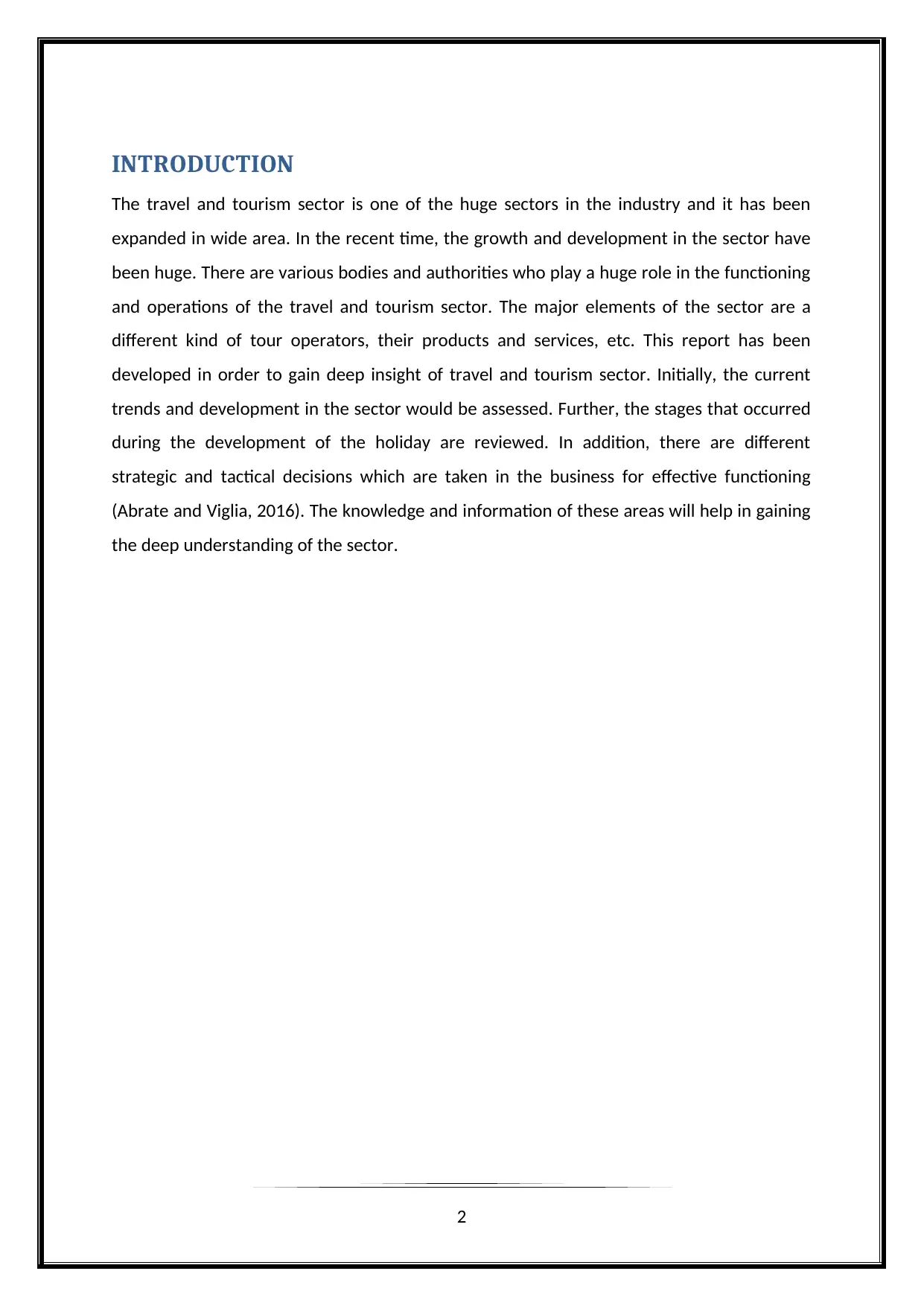
INTRODUCTION
The travel and tourism sector is one of the huge sectors in the industry and it has been
expanded in wide area. In the recent time, the growth and development in the sector have
been huge. There are various bodies and authorities who play a huge role in the functioning
and operations of the travel and tourism sector. The major elements of the sector are a
different kind of tour operators, their products and services, etc. This report has been
developed in order to gain deep insight of travel and tourism sector. Initially, the current
trends and development in the sector would be assessed. Further, the stages that occurred
during the development of the holiday are reviewed. In addition, there are different
strategic and tactical decisions which are taken in the business for effective functioning
(Abrate and Viglia, 2016). The knowledge and information of these areas will help in gaining
the deep understanding of the sector.
2
The travel and tourism sector is one of the huge sectors in the industry and it has been
expanded in wide area. In the recent time, the growth and development in the sector have
been huge. There are various bodies and authorities who play a huge role in the functioning
and operations of the travel and tourism sector. The major elements of the sector are a
different kind of tour operators, their products and services, etc. This report has been
developed in order to gain deep insight of travel and tourism sector. Initially, the current
trends and development in the sector would be assessed. Further, the stages that occurred
during the development of the holiday are reviewed. In addition, there are different
strategic and tactical decisions which are taken in the business for effective functioning
(Abrate and Viglia, 2016). The knowledge and information of these areas will help in gaining
the deep understanding of the sector.
2
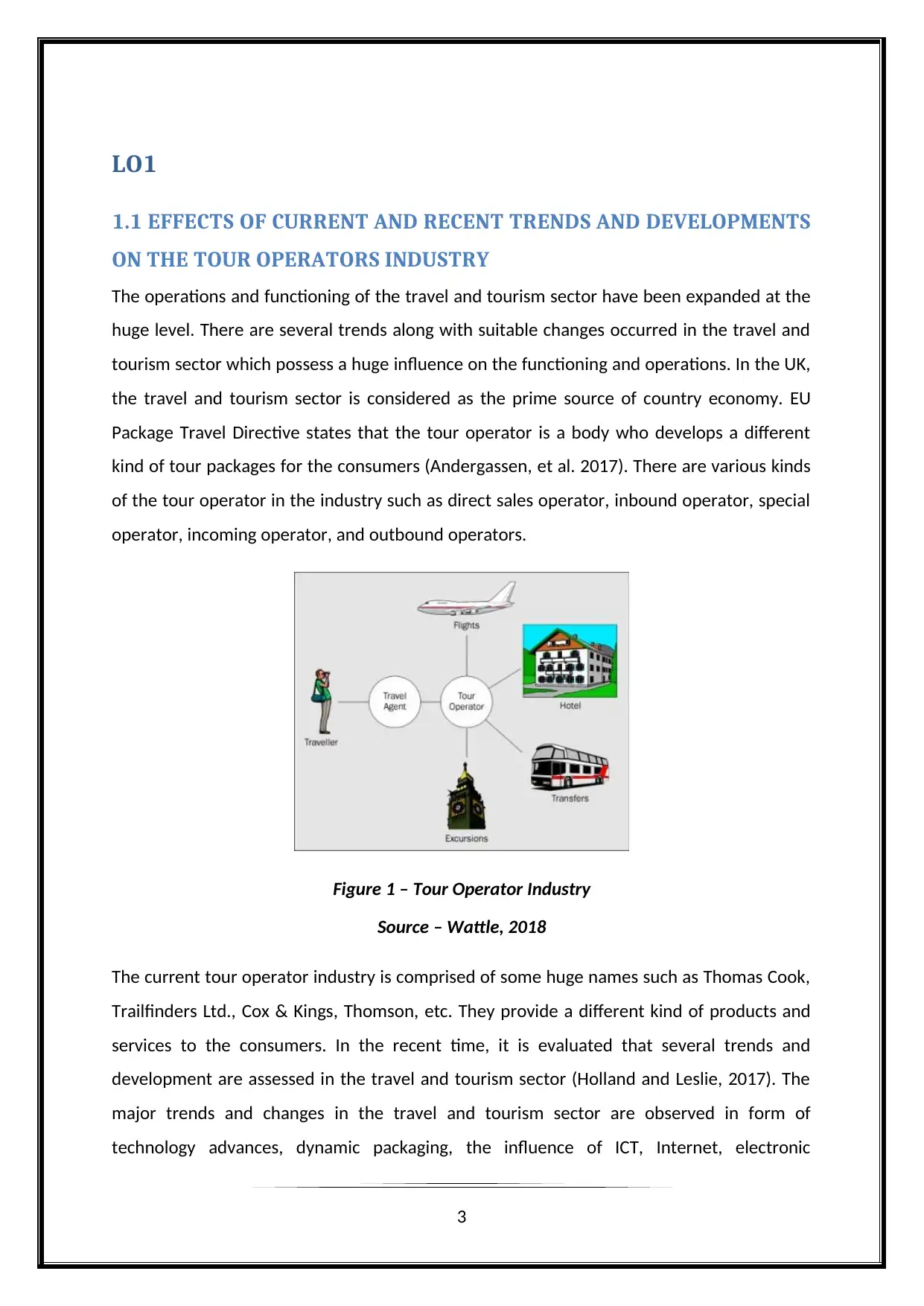
LO1
1.1 EFFECTS OF CURRENT AND RECENT TRENDS AND DEVELOPMENTS
ON THE TOUR OPERATORS INDUSTRY
The operations and functioning of the travel and tourism sector have been expanded at the
huge level. There are several trends along with suitable changes occurred in the travel and
tourism sector which possess a huge influence on the functioning and operations. In the UK,
the travel and tourism sector is considered as the prime source of country economy. EU
Package Travel Directive states that the tour operator is a body who develops a different
kind of tour packages for the consumers (Andergassen, et al. 2017). There are various kinds
of the tour operator in the industry such as direct sales operator, inbound operator, special
operator, incoming operator, and outbound operators.
Figure 1 – Tour Operator Industry
Source – Wattle, 2018
The current tour operator industry is comprised of some huge names such as Thomas Cook,
Trailfinders Ltd., Cox & Kings, Thomson, etc. They provide a different kind of products and
services to the consumers. In the recent time, it is evaluated that several trends and
development are assessed in the travel and tourism sector (Holland and Leslie, 2017). The
major trends and changes in the travel and tourism sector are observed in form of
technology advances, dynamic packaging, the influence of ICT, Internet, electronic
3
1.1 EFFECTS OF CURRENT AND RECENT TRENDS AND DEVELOPMENTS
ON THE TOUR OPERATORS INDUSTRY
The operations and functioning of the travel and tourism sector have been expanded at the
huge level. There are several trends along with suitable changes occurred in the travel and
tourism sector which possess a huge influence on the functioning and operations. In the UK,
the travel and tourism sector is considered as the prime source of country economy. EU
Package Travel Directive states that the tour operator is a body who develops a different
kind of tour packages for the consumers (Andergassen, et al. 2017). There are various kinds
of the tour operator in the industry such as direct sales operator, inbound operator, special
operator, incoming operator, and outbound operators.
Figure 1 – Tour Operator Industry
Source – Wattle, 2018
The current tour operator industry is comprised of some huge names such as Thomas Cook,
Trailfinders Ltd., Cox & Kings, Thomson, etc. They provide a different kind of products and
services to the consumers. In the recent time, it is evaluated that several trends and
development are assessed in the travel and tourism sector (Holland and Leslie, 2017). The
major trends and changes in the travel and tourism sector are observed in form of
technology advances, dynamic packaging, the influence of ICT, Internet, electronic
3
Secure Best Marks with AI Grader
Need help grading? Try our AI Grader for instant feedback on your assignments.
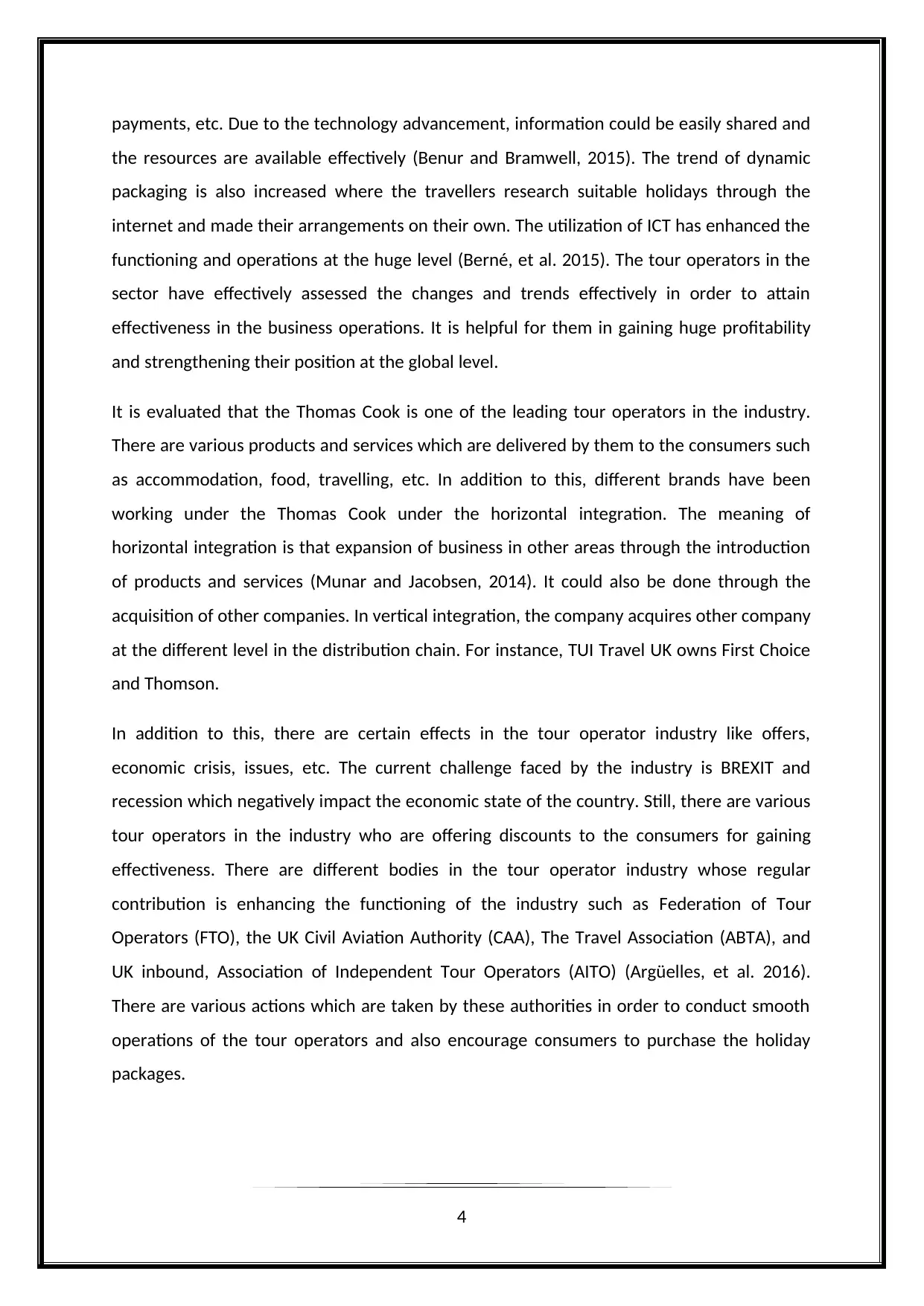
payments, etc. Due to the technology advancement, information could be easily shared and
the resources are available effectively (Benur and Bramwell, 2015). The trend of dynamic
packaging is also increased where the travellers research suitable holidays through the
internet and made their arrangements on their own. The utilization of ICT has enhanced the
functioning and operations at the huge level (Berné, et al. 2015). The tour operators in the
sector have effectively assessed the changes and trends effectively in order to attain
effectiveness in the business operations. It is helpful for them in gaining huge profitability
and strengthening their position at the global level.
It is evaluated that the Thomas Cook is one of the leading tour operators in the industry.
There are various products and services which are delivered by them to the consumers such
as accommodation, food, travelling, etc. In addition to this, different brands have been
working under the Thomas Cook under the horizontal integration. The meaning of
horizontal integration is that expansion of business in other areas through the introduction
of products and services (Munar and Jacobsen, 2014). It could also be done through the
acquisition of other companies. In vertical integration, the company acquires other company
at the different level in the distribution chain. For instance, TUI Travel UK owns First Choice
and Thomson.
In addition to this, there are certain effects in the tour operator industry like offers,
economic crisis, issues, etc. The current challenge faced by the industry is BREXIT and
recession which negatively impact the economic state of the country. Still, there are various
tour operators in the industry who are offering discounts to the consumers for gaining
effectiveness. There are different bodies in the tour operator industry whose regular
contribution is enhancing the functioning of the industry such as Federation of Tour
Operators (FTO), the UK Civil Aviation Authority (CAA), The Travel Association (ABTA), and
UK inbound, Association of Independent Tour Operators (AITO) (Argüelles, et al. 2016).
There are various actions which are taken by these authorities in order to conduct smooth
operations of the tour operators and also encourage consumers to purchase the holiday
packages.
4
the resources are available effectively (Benur and Bramwell, 2015). The trend of dynamic
packaging is also increased where the travellers research suitable holidays through the
internet and made their arrangements on their own. The utilization of ICT has enhanced the
functioning and operations at the huge level (Berné, et al. 2015). The tour operators in the
sector have effectively assessed the changes and trends effectively in order to attain
effectiveness in the business operations. It is helpful for them in gaining huge profitability
and strengthening their position at the global level.
It is evaluated that the Thomas Cook is one of the leading tour operators in the industry.
There are various products and services which are delivered by them to the consumers such
as accommodation, food, travelling, etc. In addition to this, different brands have been
working under the Thomas Cook under the horizontal integration. The meaning of
horizontal integration is that expansion of business in other areas through the introduction
of products and services (Munar and Jacobsen, 2014). It could also be done through the
acquisition of other companies. In vertical integration, the company acquires other company
at the different level in the distribution chain. For instance, TUI Travel UK owns First Choice
and Thomson.
In addition to this, there are certain effects in the tour operator industry like offers,
economic crisis, issues, etc. The current challenge faced by the industry is BREXIT and
recession which negatively impact the economic state of the country. Still, there are various
tour operators in the industry who are offering discounts to the consumers for gaining
effectiveness. There are different bodies in the tour operator industry whose regular
contribution is enhancing the functioning of the industry such as Federation of Tour
Operators (FTO), the UK Civil Aviation Authority (CAA), The Travel Association (ABTA), and
UK inbound, Association of Independent Tour Operators (AITO) (Argüelles, et al. 2016).
There are various actions which are taken by these authorities in order to conduct smooth
operations of the tour operators and also encourage consumers to purchase the holiday
packages.
4
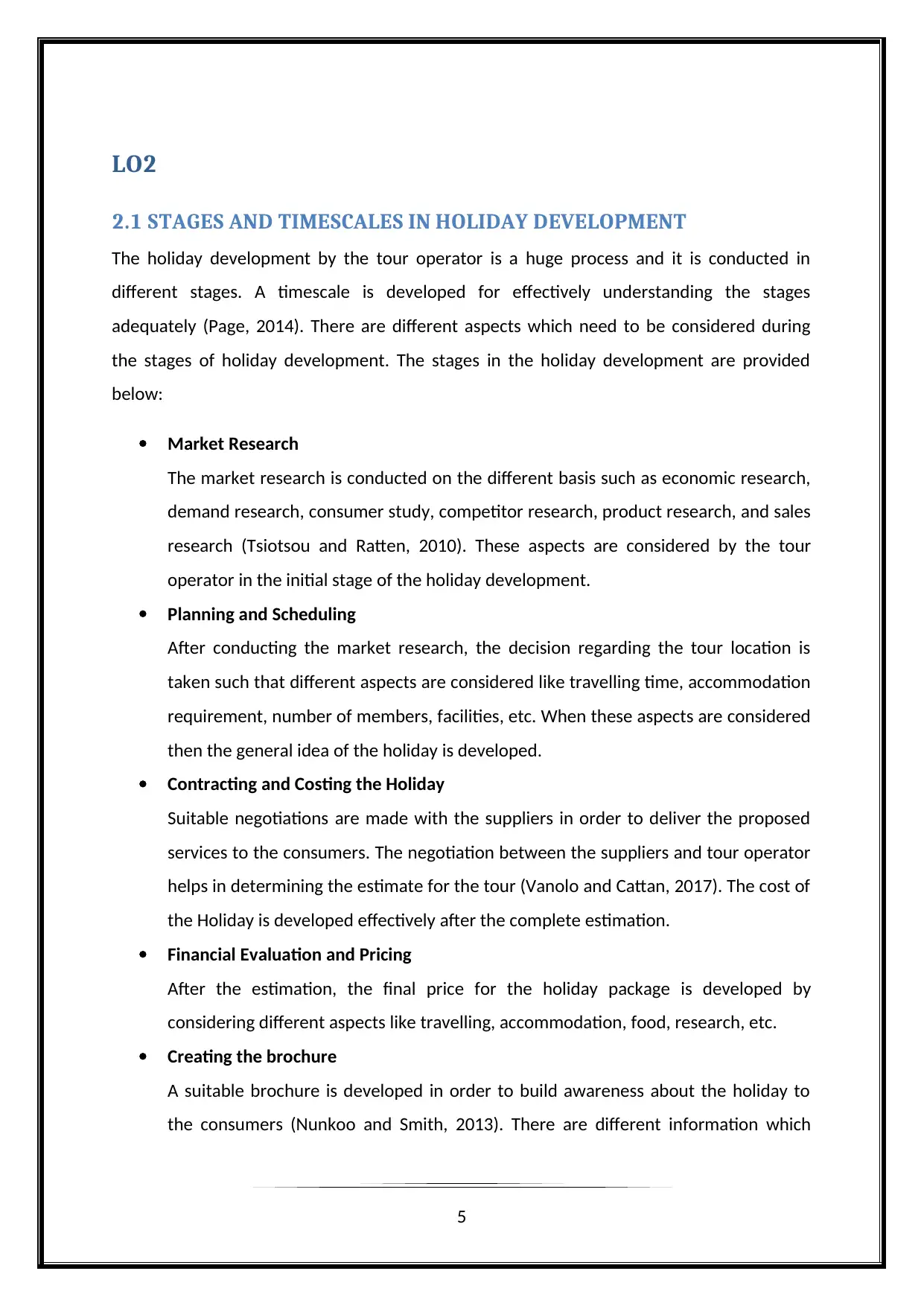
LO2
2.1 STAGES AND TIMESCALES IN HOLIDAY DEVELOPMENT
The holiday development by the tour operator is a huge process and it is conducted in
different stages. A timescale is developed for effectively understanding the stages
adequately (Page, 2014). There are different aspects which need to be considered during
the stages of holiday development. The stages in the holiday development are provided
below:
Market Research
The market research is conducted on the different basis such as economic research,
demand research, consumer study, competitor research, product research, and sales
research (Tsiotsou and Ratten, 2010). These aspects are considered by the tour
operator in the initial stage of the holiday development.
Planning and Scheduling
After conducting the market research, the decision regarding the tour location is
taken such that different aspects are considered like travelling time, accommodation
requirement, number of members, facilities, etc. When these aspects are considered
then the general idea of the holiday is developed.
Contracting and Costing the Holiday
Suitable negotiations are made with the suppliers in order to deliver the proposed
services to the consumers. The negotiation between the suppliers and tour operator
helps in determining the estimate for the tour (Vanolo and Cattan, 2017). The cost of
the Holiday is developed effectively after the complete estimation.
Financial Evaluation and Pricing
After the estimation, the final price for the holiday package is developed by
considering different aspects like travelling, accommodation, food, research, etc.
Creating the brochure
A suitable brochure is developed in order to build awareness about the holiday to
the consumers (Nunkoo and Smith, 2013). There are different information which
5
2.1 STAGES AND TIMESCALES IN HOLIDAY DEVELOPMENT
The holiday development by the tour operator is a huge process and it is conducted in
different stages. A timescale is developed for effectively understanding the stages
adequately (Page, 2014). There are different aspects which need to be considered during
the stages of holiday development. The stages in the holiday development are provided
below:
Market Research
The market research is conducted on the different basis such as economic research,
demand research, consumer study, competitor research, product research, and sales
research (Tsiotsou and Ratten, 2010). These aspects are considered by the tour
operator in the initial stage of the holiday development.
Planning and Scheduling
After conducting the market research, the decision regarding the tour location is
taken such that different aspects are considered like travelling time, accommodation
requirement, number of members, facilities, etc. When these aspects are considered
then the general idea of the holiday is developed.
Contracting and Costing the Holiday
Suitable negotiations are made with the suppliers in order to deliver the proposed
services to the consumers. The negotiation between the suppliers and tour operator
helps in determining the estimate for the tour (Vanolo and Cattan, 2017). The cost of
the Holiday is developed effectively after the complete estimation.
Financial Evaluation and Pricing
After the estimation, the final price for the holiday package is developed by
considering different aspects like travelling, accommodation, food, research, etc.
Creating the brochure
A suitable brochure is developed in order to build awareness about the holiday to
the consumers (Nunkoo and Smith, 2013). There are different information which
5
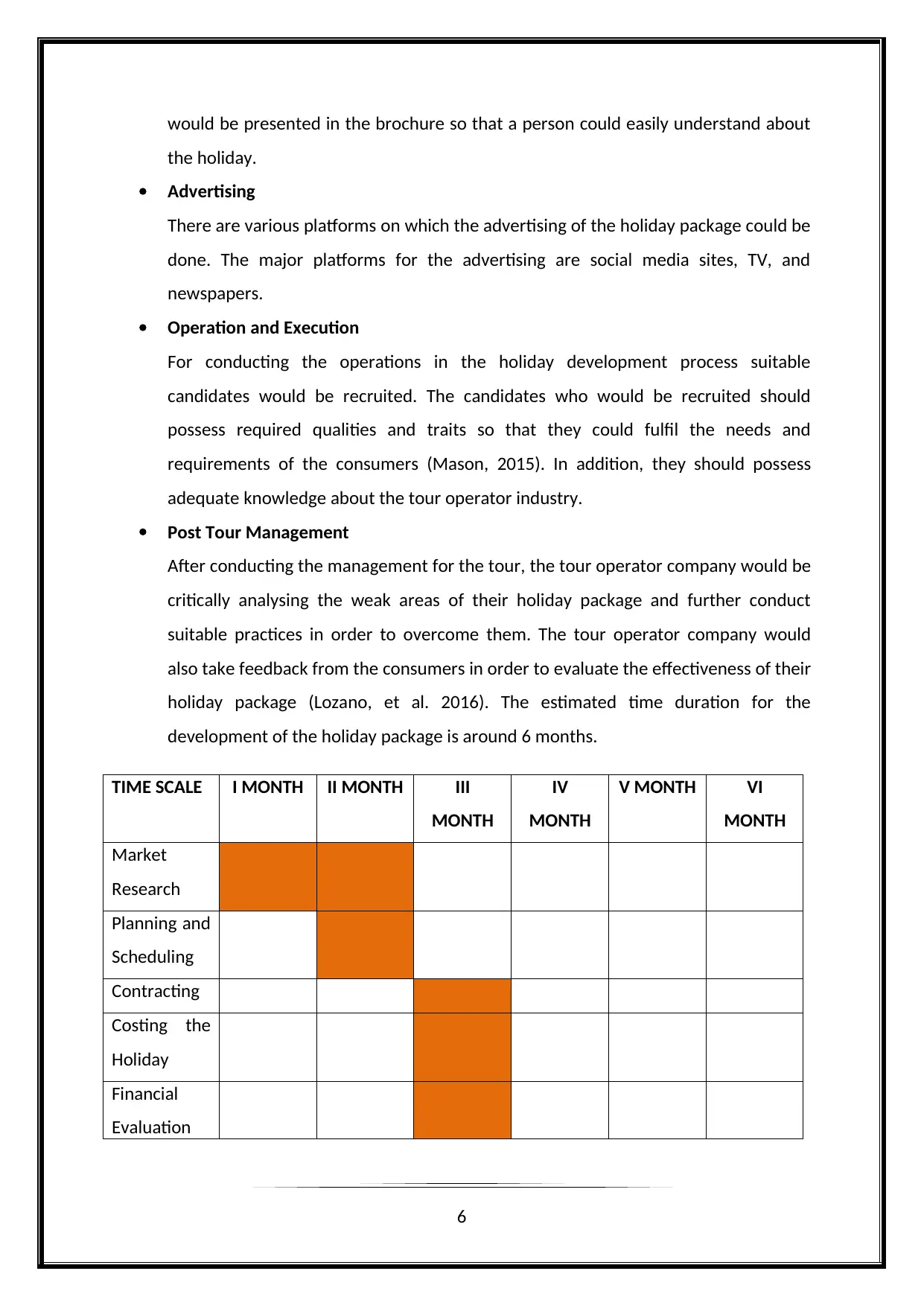
would be presented in the brochure so that a person could easily understand about
the holiday.
Advertising
There are various platforms on which the advertising of the holiday package could be
done. The major platforms for the advertising are social media sites, TV, and
newspapers.
Operation and Execution
For conducting the operations in the holiday development process suitable
candidates would be recruited. The candidates who would be recruited should
possess required qualities and traits so that they could fulfil the needs and
requirements of the consumers (Mason, 2015). In addition, they should possess
adequate knowledge about the tour operator industry.
Post Tour Management
After conducting the management for the tour, the tour operator company would be
critically analysing the weak areas of their holiday package and further conduct
suitable practices in order to overcome them. The tour operator company would
also take feedback from the consumers in order to evaluate the effectiveness of their
holiday package (Lozano, et al. 2016). The estimated time duration for the
development of the holiday package is around 6 months.
TIME SCALE I MONTH II MONTH III
MONTH
IV
MONTH
V MONTH VI
MONTH
Market
Research
Planning and
Scheduling
Contracting
Costing the
Holiday
Financial
Evaluation
6
the holiday.
Advertising
There are various platforms on which the advertising of the holiday package could be
done. The major platforms for the advertising are social media sites, TV, and
newspapers.
Operation and Execution
For conducting the operations in the holiday development process suitable
candidates would be recruited. The candidates who would be recruited should
possess required qualities and traits so that they could fulfil the needs and
requirements of the consumers (Mason, 2015). In addition, they should possess
adequate knowledge about the tour operator industry.
Post Tour Management
After conducting the management for the tour, the tour operator company would be
critically analysing the weak areas of their holiday package and further conduct
suitable practices in order to overcome them. The tour operator company would
also take feedback from the consumers in order to evaluate the effectiveness of their
holiday package (Lozano, et al. 2016). The estimated time duration for the
development of the holiday package is around 6 months.
TIME SCALE I MONTH II MONTH III
MONTH
IV
MONTH
V MONTH VI
MONTH
Market
Research
Planning and
Scheduling
Contracting
Costing the
Holiday
Financial
Evaluation
6
Paraphrase This Document
Need a fresh take? Get an instant paraphrase of this document with our AI Paraphraser
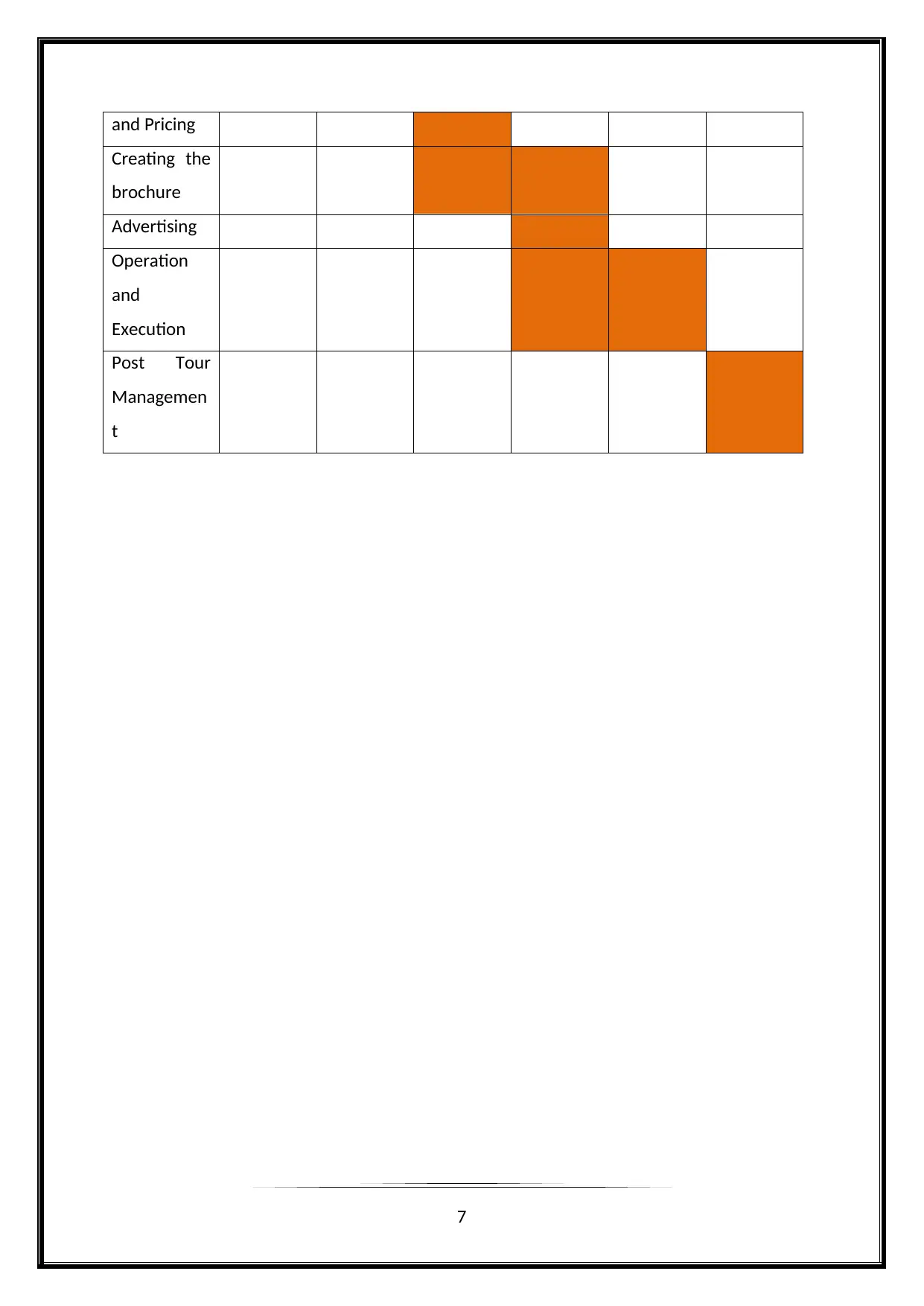
and Pricing
Creating the
brochure
Advertising
Operation
and
Execution
Post Tour
Managemen
t
7
Creating the
brochure
Advertising
Operation
and
Execution
Post Tour
Managemen
t
7
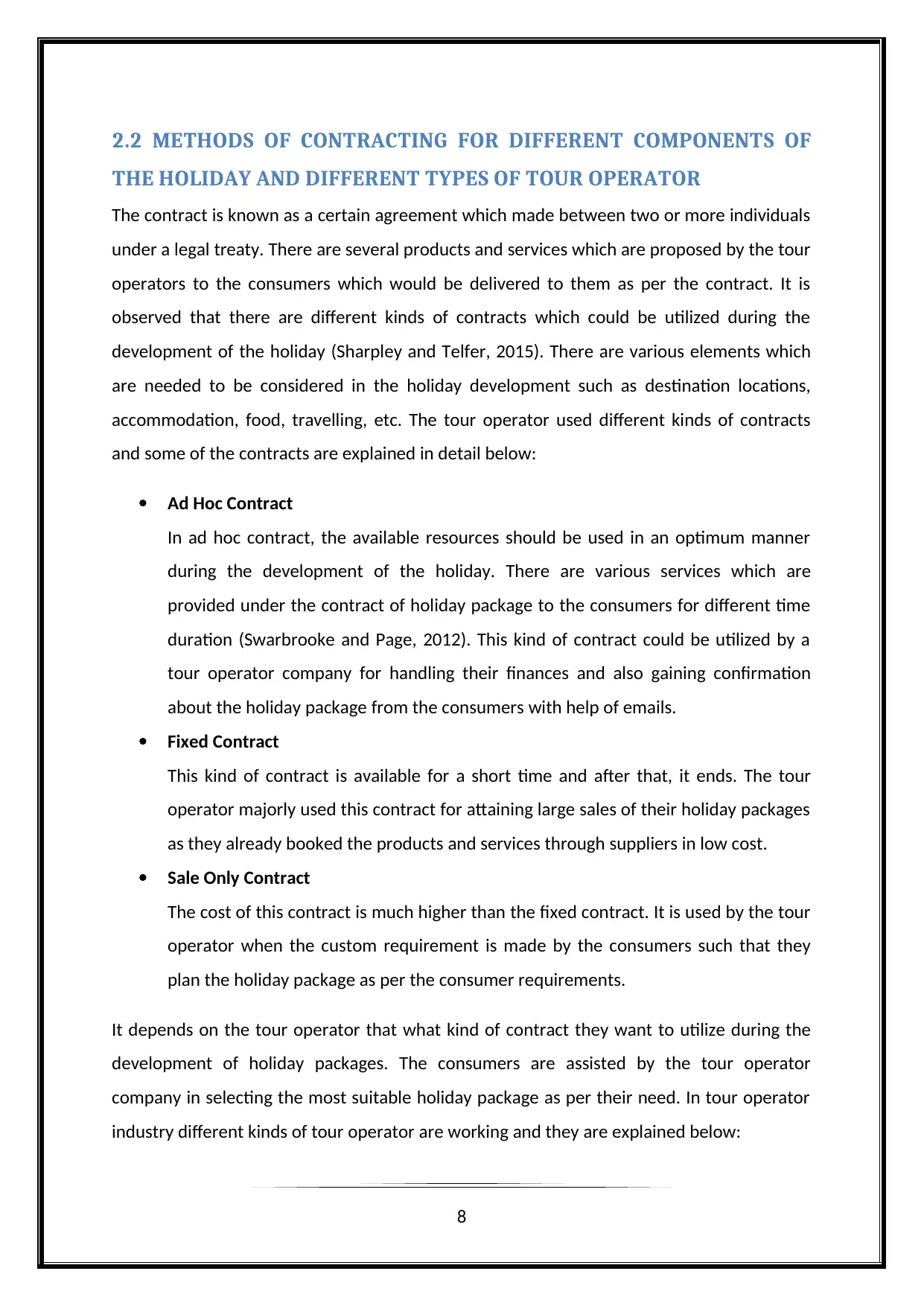
2.2 METHODS OF CONTRACTING FOR DIFFERENT COMPONENTS OF
THE HOLIDAY AND DIFFERENT TYPES OF TOUR OPERATOR
The contract is known as a certain agreement which made between two or more individuals
under a legal treaty. There are several products and services which are proposed by the tour
operators to the consumers which would be delivered to them as per the contract. It is
observed that there are different kinds of contracts which could be utilized during the
development of the holiday (Sharpley and Telfer, 2015). There are various elements which
are needed to be considered in the holiday development such as destination locations,
accommodation, food, travelling, etc. The tour operator used different kinds of contracts
and some of the contracts are explained in detail below:
Ad Hoc Contract
In ad hoc contract, the available resources should be used in an optimum manner
during the development of the holiday. There are various services which are
provided under the contract of holiday package to the consumers for different time
duration (Swarbrooke and Page, 2012). This kind of contract could be utilized by a
tour operator company for handling their finances and also gaining confirmation
about the holiday package from the consumers with help of emails.
Fixed Contract
This kind of contract is available for a short time and after that, it ends. The tour
operator majorly used this contract for attaining large sales of their holiday packages
as they already booked the products and services through suppliers in low cost.
Sale Only Contract
The cost of this contract is much higher than the fixed contract. It is used by the tour
operator when the custom requirement is made by the consumers such that they
plan the holiday package as per the consumer requirements.
It depends on the tour operator that what kind of contract they want to utilize during the
development of holiday packages. The consumers are assisted by the tour operator
company in selecting the most suitable holiday package as per their need. In tour operator
industry different kinds of tour operator are working and they are explained below:
8
THE HOLIDAY AND DIFFERENT TYPES OF TOUR OPERATOR
The contract is known as a certain agreement which made between two or more individuals
under a legal treaty. There are several products and services which are proposed by the tour
operators to the consumers which would be delivered to them as per the contract. It is
observed that there are different kinds of contracts which could be utilized during the
development of the holiday (Sharpley and Telfer, 2015). There are various elements which
are needed to be considered in the holiday development such as destination locations,
accommodation, food, travelling, etc. The tour operator used different kinds of contracts
and some of the contracts are explained in detail below:
Ad Hoc Contract
In ad hoc contract, the available resources should be used in an optimum manner
during the development of the holiday. There are various services which are
provided under the contract of holiday package to the consumers for different time
duration (Swarbrooke and Page, 2012). This kind of contract could be utilized by a
tour operator company for handling their finances and also gaining confirmation
about the holiday package from the consumers with help of emails.
Fixed Contract
This kind of contract is available for a short time and after that, it ends. The tour
operator majorly used this contract for attaining large sales of their holiday packages
as they already booked the products and services through suppliers in low cost.
Sale Only Contract
The cost of this contract is much higher than the fixed contract. It is used by the tour
operator when the custom requirement is made by the consumers such that they
plan the holiday package as per the consumer requirements.
It depends on the tour operator that what kind of contract they want to utilize during the
development of holiday packages. The consumers are assisted by the tour operator
company in selecting the most suitable holiday package as per their need. In tour operator
industry different kinds of tour operator are working and they are explained below:
8
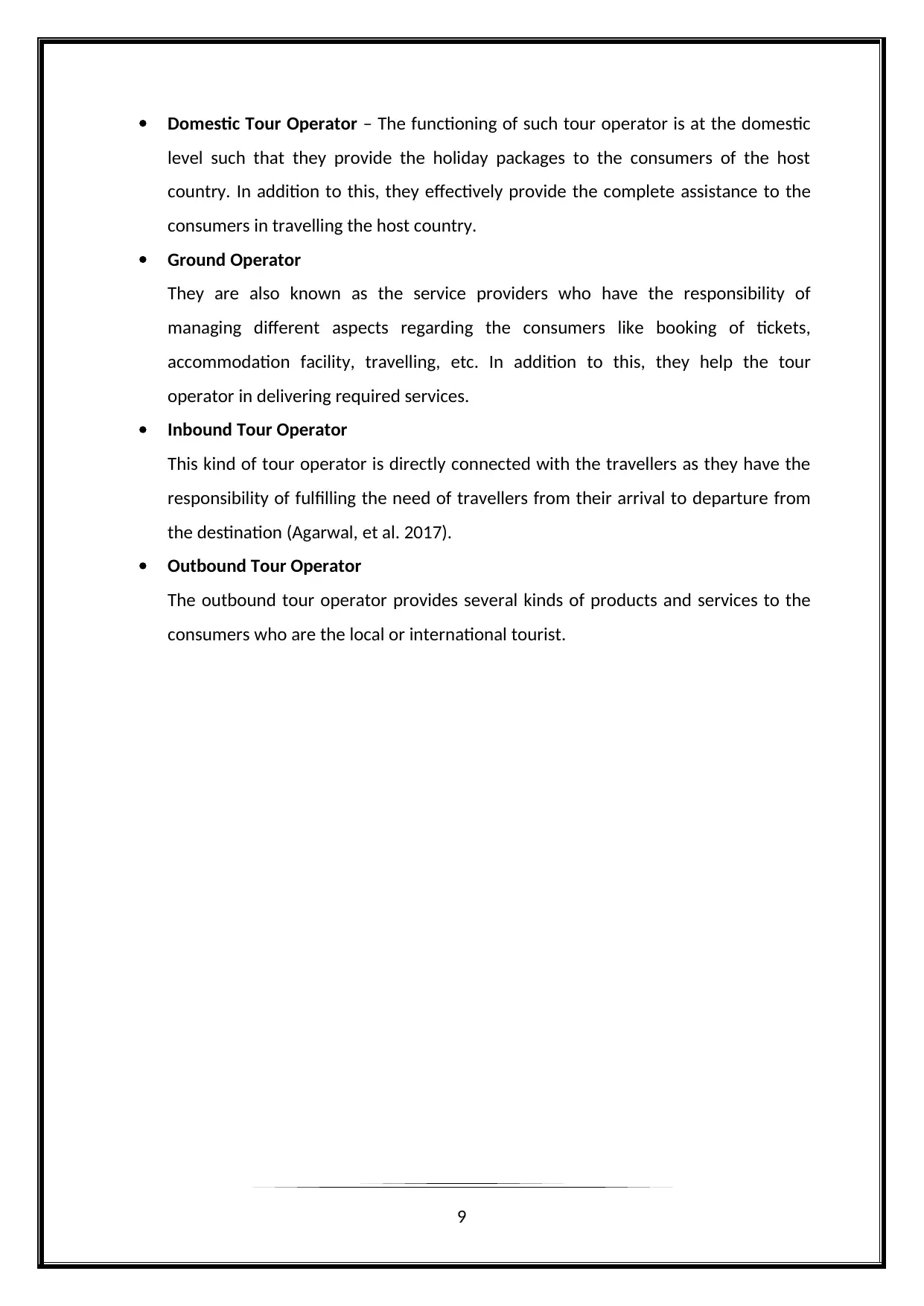
Domestic Tour Operator – The functioning of such tour operator is at the domestic
level such that they provide the holiday packages to the consumers of the host
country. In addition to this, they effectively provide the complete assistance to the
consumers in travelling the host country.
Ground Operator
They are also known as the service providers who have the responsibility of
managing different aspects regarding the consumers like booking of tickets,
accommodation facility, travelling, etc. In addition to this, they help the tour
operator in delivering required services.
Inbound Tour Operator
This kind of tour operator is directly connected with the travellers as they have the
responsibility of fulfilling the need of travellers from their arrival to departure from
the destination (Agarwal, et al. 2017).
Outbound Tour Operator
The outbound tour operator provides several kinds of products and services to the
consumers who are the local or international tourist.
9
level such that they provide the holiday packages to the consumers of the host
country. In addition to this, they effectively provide the complete assistance to the
consumers in travelling the host country.
Ground Operator
They are also known as the service providers who have the responsibility of
managing different aspects regarding the consumers like booking of tickets,
accommodation facility, travelling, etc. In addition to this, they help the tour
operator in delivering required services.
Inbound Tour Operator
This kind of tour operator is directly connected with the travellers as they have the
responsibility of fulfilling the need of travellers from their arrival to departure from
the destination (Agarwal, et al. 2017).
Outbound Tour Operator
The outbound tour operator provides several kinds of products and services to the
consumers who are the local or international tourist.
9
Secure Best Marks with AI Grader
Need help grading? Try our AI Grader for instant feedback on your assignments.
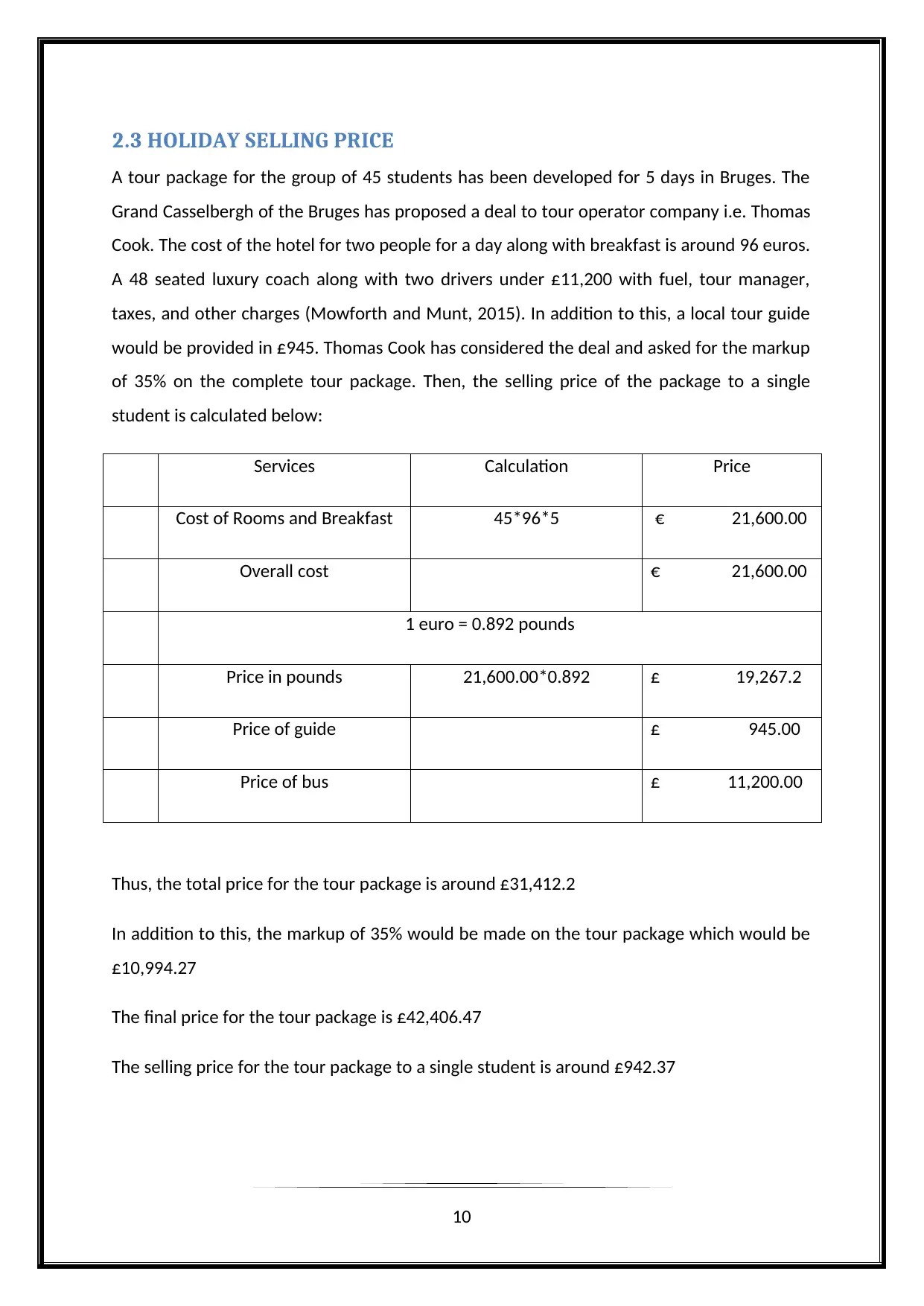
2.3 HOLIDAY SELLING PRICE
A tour package for the group of 45 students has been developed for 5 days in Bruges. The
Grand Casselbergh of the Bruges has proposed a deal to tour operator company i.e. Thomas
Cook. The cost of the hotel for two people for a day along with breakfast is around 96 euros.
A 48 seated luxury coach along with two drivers under £11,200 with fuel, tour manager,
taxes, and other charges (Mowforth and Munt, 2015). In addition to this, a local tour guide
would be provided in £945. Thomas Cook has considered the deal and asked for the markup
of 35% on the complete tour package. Then, the selling price of the package to a single
student is calculated below:
Services Calculation Price
Cost of Rooms and Breakfast 45*96*5 € 21,600.00
Overall cost € 21,600.00
1 euro = 0.892 pounds
Price in pounds 21,600.00*0.892 £ 19,267.2
Price of guide £ 945.00
Price of bus £ 11,200.00
Thus, the total price for the tour package is around £31,412.2
In addition to this, the markup of 35% would be made on the tour package which would be
£10,994.27
The final price for the tour package is £42,406.47
The selling price for the tour package to a single student is around £942.37
10
A tour package for the group of 45 students has been developed for 5 days in Bruges. The
Grand Casselbergh of the Bruges has proposed a deal to tour operator company i.e. Thomas
Cook. The cost of the hotel for two people for a day along with breakfast is around 96 euros.
A 48 seated luxury coach along with two drivers under £11,200 with fuel, tour manager,
taxes, and other charges (Mowforth and Munt, 2015). In addition to this, a local tour guide
would be provided in £945. Thomas Cook has considered the deal and asked for the markup
of 35% on the complete tour package. Then, the selling price of the package to a single
student is calculated below:
Services Calculation Price
Cost of Rooms and Breakfast 45*96*5 € 21,600.00
Overall cost € 21,600.00
1 euro = 0.892 pounds
Price in pounds 21,600.00*0.892 £ 19,267.2
Price of guide £ 945.00
Price of bus £ 11,200.00
Thus, the total price for the tour package is around £31,412.2
In addition to this, the markup of 35% would be made on the tour package which would be
£10,994.27
The final price for the tour package is £42,406.47
The selling price for the tour package to a single student is around £942.37
10
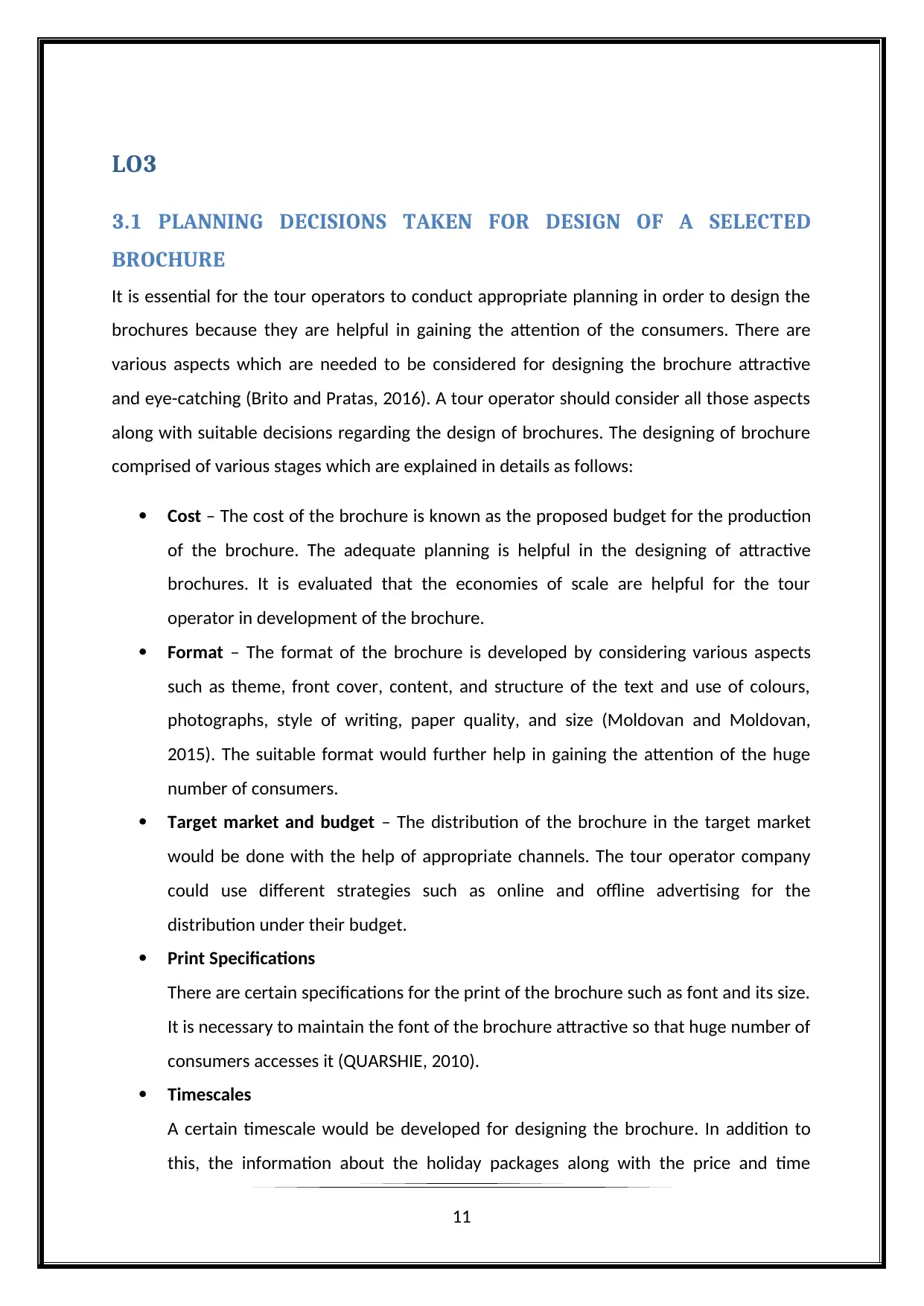
LO3
3.1 PLANNING DECISIONS TAKEN FOR DESIGN OF A SELECTED
BROCHURE
It is essential for the tour operators to conduct appropriate planning in order to design the
brochures because they are helpful in gaining the attention of the consumers. There are
various aspects which are needed to be considered for designing the brochure attractive
and eye-catching (Brito and Pratas, 2016). A tour operator should consider all those aspects
along with suitable decisions regarding the design of brochures. The designing of brochure
comprised of various stages which are explained in details as follows:
Cost – The cost of the brochure is known as the proposed budget for the production
of the brochure. The adequate planning is helpful in the designing of attractive
brochures. It is evaluated that the economies of scale are helpful for the tour
operator in development of the brochure.
Format – The format of the brochure is developed by considering various aspects
such as theme, front cover, content, and structure of the text and use of colours,
photographs, style of writing, paper quality, and size (Moldovan and Moldovan,
2015). The suitable format would further help in gaining the attention of the huge
number of consumers.
Target market and budget – The distribution of the brochure in the target market
would be done with the help of appropriate channels. The tour operator company
could use different strategies such as online and offline advertising for the
distribution under their budget.
Print Specifications
There are certain specifications for the print of the brochure such as font and its size.
It is necessary to maintain the font of the brochure attractive so that huge number of
consumers accesses it (QUARSHIE, 2010).
Timescales
A certain timescale would be developed for designing the brochure. In addition to
this, the information about the holiday packages along with the price and time
11
3.1 PLANNING DECISIONS TAKEN FOR DESIGN OF A SELECTED
BROCHURE
It is essential for the tour operators to conduct appropriate planning in order to design the
brochures because they are helpful in gaining the attention of the consumers. There are
various aspects which are needed to be considered for designing the brochure attractive
and eye-catching (Brito and Pratas, 2016). A tour operator should consider all those aspects
along with suitable decisions regarding the design of brochures. The designing of brochure
comprised of various stages which are explained in details as follows:
Cost – The cost of the brochure is known as the proposed budget for the production
of the brochure. The adequate planning is helpful in the designing of attractive
brochures. It is evaluated that the economies of scale are helpful for the tour
operator in development of the brochure.
Format – The format of the brochure is developed by considering various aspects
such as theme, front cover, content, and structure of the text and use of colours,
photographs, style of writing, paper quality, and size (Moldovan and Moldovan,
2015). The suitable format would further help in gaining the attention of the huge
number of consumers.
Target market and budget – The distribution of the brochure in the target market
would be done with the help of appropriate channels. The tour operator company
could use different strategies such as online and offline advertising for the
distribution under their budget.
Print Specifications
There are certain specifications for the print of the brochure such as font and its size.
It is necessary to maintain the font of the brochure attractive so that huge number of
consumers accesses it (QUARSHIE, 2010).
Timescales
A certain timescale would be developed for designing the brochure. In addition to
this, the information about the holiday packages along with the price and time
11
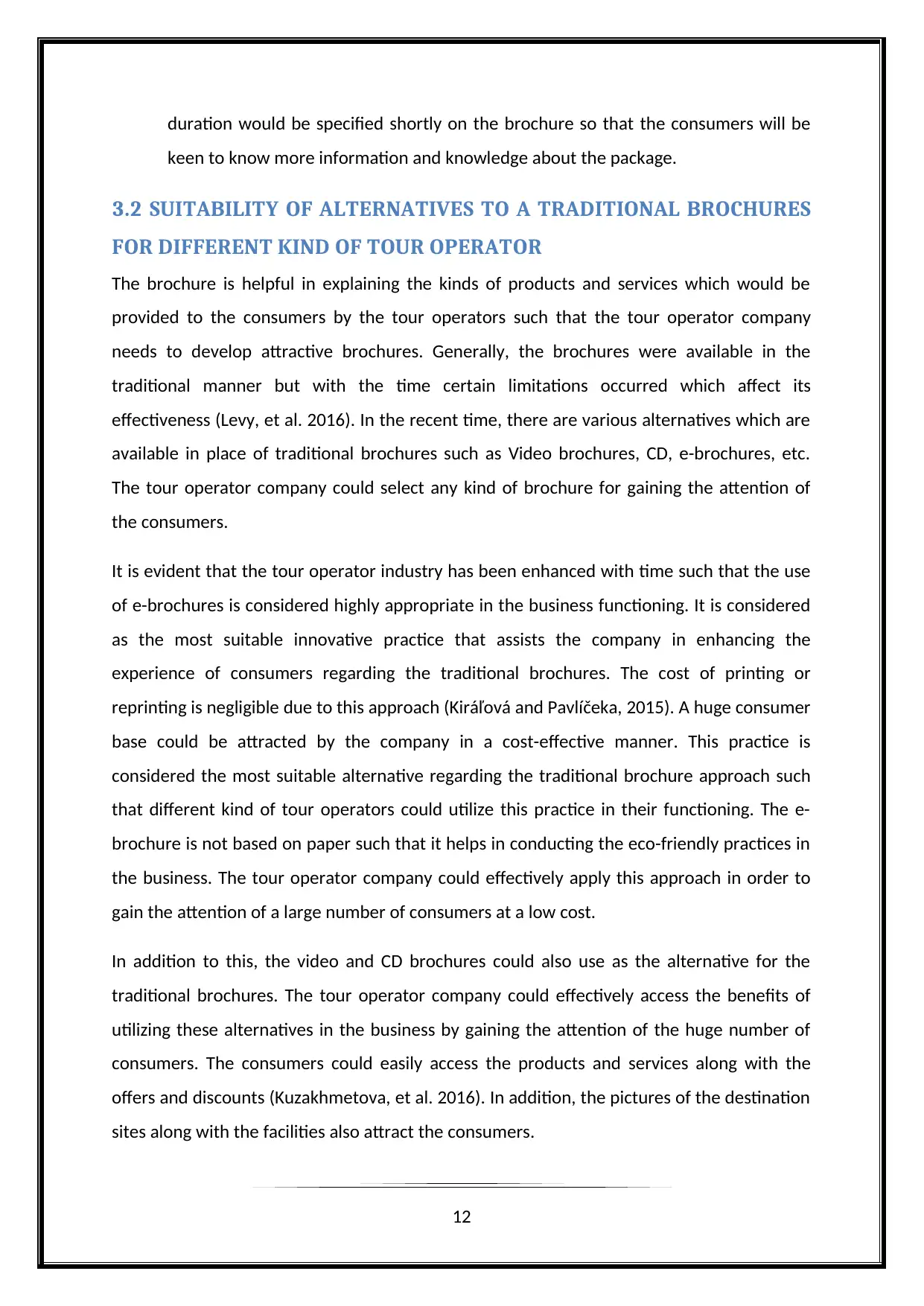
duration would be specified shortly on the brochure so that the consumers will be
keen to know more information and knowledge about the package.
3.2 SUITABILITY OF ALTERNATIVES TO A TRADITIONAL BROCHURES
FOR DIFFERENT KIND OF TOUR OPERATOR
The brochure is helpful in explaining the kinds of products and services which would be
provided to the consumers by the tour operators such that the tour operator company
needs to develop attractive brochures. Generally, the brochures were available in the
traditional manner but with the time certain limitations occurred which affect its
effectiveness (Levy, et al. 2016). In the recent time, there are various alternatives which are
available in place of traditional brochures such as Video brochures, CD, e-brochures, etc.
The tour operator company could select any kind of brochure for gaining the attention of
the consumers.
It is evident that the tour operator industry has been enhanced with time such that the use
of e-brochures is considered highly appropriate in the business functioning. It is considered
as the most suitable innovative practice that assists the company in enhancing the
experience of consumers regarding the traditional brochures. The cost of printing or
reprinting is negligible due to this approach (Kiráľová and Pavlíčeka, 2015). A huge consumer
base could be attracted by the company in a cost-effective manner. This practice is
considered the most suitable alternative regarding the traditional brochure approach such
that different kind of tour operators could utilize this practice in their functioning. The e-
brochure is not based on paper such that it helps in conducting the eco-friendly practices in
the business. The tour operator company could effectively apply this approach in order to
gain the attention of a large number of consumers at a low cost.
In addition to this, the video and CD brochures could also use as the alternative for the
traditional brochures. The tour operator company could effectively access the benefits of
utilizing these alternatives in the business by gaining the attention of the huge number of
consumers. The consumers could easily access the products and services along with the
offers and discounts (Kuzakhmetova, et al. 2016). In addition, the pictures of the destination
sites along with the facilities also attract the consumers.
12
keen to know more information and knowledge about the package.
3.2 SUITABILITY OF ALTERNATIVES TO A TRADITIONAL BROCHURES
FOR DIFFERENT KIND OF TOUR OPERATOR
The brochure is helpful in explaining the kinds of products and services which would be
provided to the consumers by the tour operators such that the tour operator company
needs to develop attractive brochures. Generally, the brochures were available in the
traditional manner but with the time certain limitations occurred which affect its
effectiveness (Levy, et al. 2016). In the recent time, there are various alternatives which are
available in place of traditional brochures such as Video brochures, CD, e-brochures, etc.
The tour operator company could select any kind of brochure for gaining the attention of
the consumers.
It is evident that the tour operator industry has been enhanced with time such that the use
of e-brochures is considered highly appropriate in the business functioning. It is considered
as the most suitable innovative practice that assists the company in enhancing the
experience of consumers regarding the traditional brochures. The cost of printing or
reprinting is negligible due to this approach (Kiráľová and Pavlíčeka, 2015). A huge consumer
base could be attracted by the company in a cost-effective manner. This practice is
considered the most suitable alternative regarding the traditional brochure approach such
that different kind of tour operators could utilize this practice in their functioning. The e-
brochure is not based on paper such that it helps in conducting the eco-friendly practices in
the business. The tour operator company could effectively apply this approach in order to
gain the attention of a large number of consumers at a low cost.
In addition to this, the video and CD brochures could also use as the alternative for the
traditional brochures. The tour operator company could effectively access the benefits of
utilizing these alternatives in the business by gaining the attention of the huge number of
consumers. The consumers could easily access the products and services along with the
offers and discounts (Kuzakhmetova, et al. 2016). In addition, the pictures of the destination
sites along with the facilities also attract the consumers.
12
Paraphrase This Document
Need a fresh take? Get an instant paraphrase of this document with our AI Paraphraser
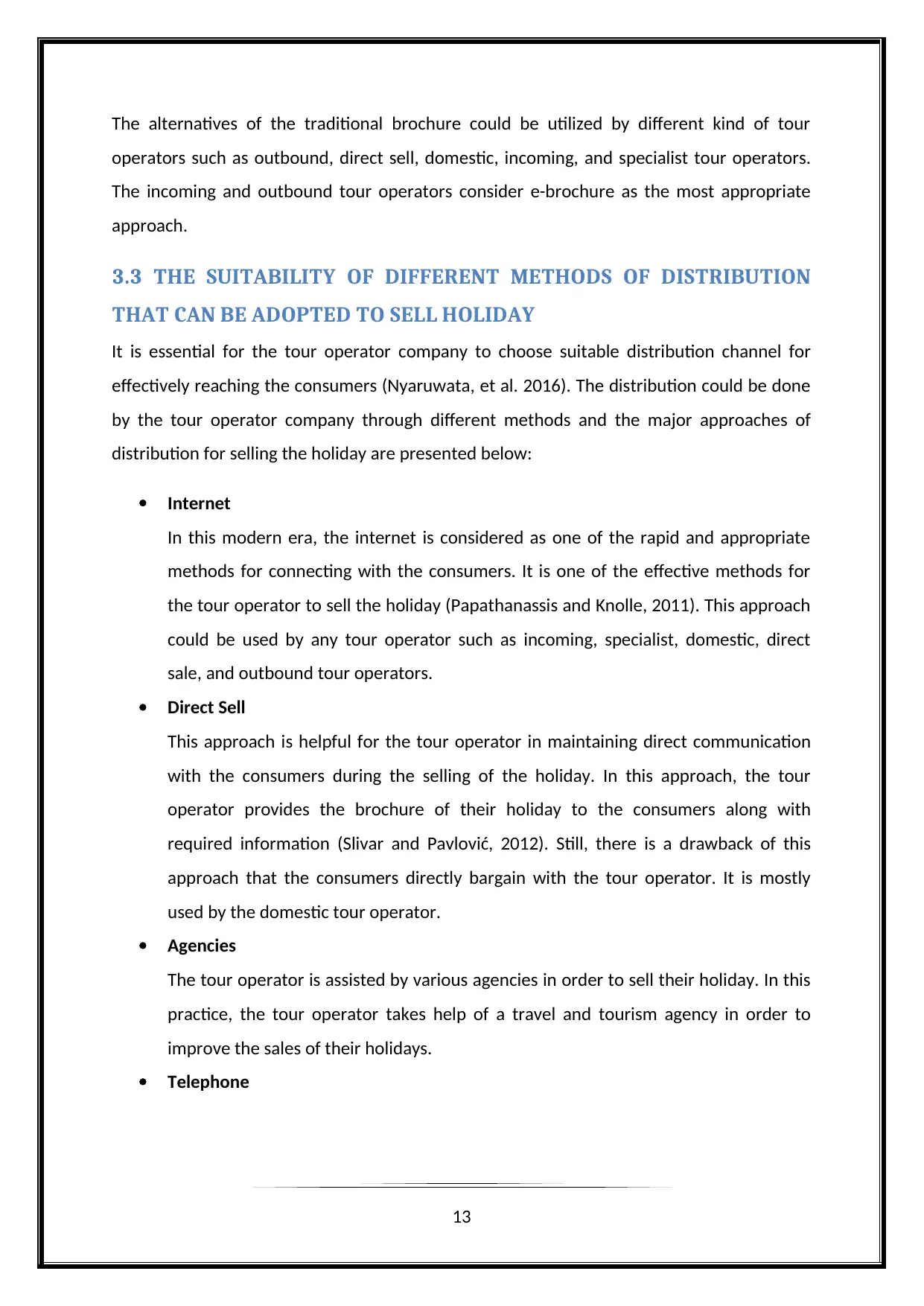
The alternatives of the traditional brochure could be utilized by different kind of tour
operators such as outbound, direct sell, domestic, incoming, and specialist tour operators.
The incoming and outbound tour operators consider e-brochure as the most appropriate
approach.
3.3 THE SUITABILITY OF DIFFERENT METHODS OF DISTRIBUTION
THAT CAN BE ADOPTED TO SELL HOLIDAY
It is essential for the tour operator company to choose suitable distribution channel for
effectively reaching the consumers (Nyaruwata, et al. 2016). The distribution could be done
by the tour operator company through different methods and the major approaches of
distribution for selling the holiday are presented below:
Internet
In this modern era, the internet is considered as one of the rapid and appropriate
methods for connecting with the consumers. It is one of the effective methods for
the tour operator to sell the holiday (Papathanassis and Knolle, 2011). This approach
could be used by any tour operator such as incoming, specialist, domestic, direct
sale, and outbound tour operators.
Direct Sell
This approach is helpful for the tour operator in maintaining direct communication
with the consumers during the selling of the holiday. In this approach, the tour
operator provides the brochure of their holiday to the consumers along with
required information (Slivar and Pavlović, 2012). Still, there is a drawback of this
approach that the consumers directly bargain with the tour operator. It is mostly
used by the domestic tour operator.
Agencies
The tour operator is assisted by various agencies in order to sell their holiday. In this
practice, the tour operator takes help of a travel and tourism agency in order to
improve the sales of their holidays.
Telephone
13
operators such as outbound, direct sell, domestic, incoming, and specialist tour operators.
The incoming and outbound tour operators consider e-brochure as the most appropriate
approach.
3.3 THE SUITABILITY OF DIFFERENT METHODS OF DISTRIBUTION
THAT CAN BE ADOPTED TO SELL HOLIDAY
It is essential for the tour operator company to choose suitable distribution channel for
effectively reaching the consumers (Nyaruwata, et al. 2016). The distribution could be done
by the tour operator company through different methods and the major approaches of
distribution for selling the holiday are presented below:
Internet
In this modern era, the internet is considered as one of the rapid and appropriate
methods for connecting with the consumers. It is one of the effective methods for
the tour operator to sell the holiday (Papathanassis and Knolle, 2011). This approach
could be used by any tour operator such as incoming, specialist, domestic, direct
sale, and outbound tour operators.
Direct Sell
This approach is helpful for the tour operator in maintaining direct communication
with the consumers during the selling of the holiday. In this approach, the tour
operator provides the brochure of their holiday to the consumers along with
required information (Slivar and Pavlović, 2012). Still, there is a drawback of this
approach that the consumers directly bargain with the tour operator. It is mostly
used by the domestic tour operator.
Agencies
The tour operator is assisted by various agencies in order to sell their holiday. In this
practice, the tour operator takes help of a travel and tourism agency in order to
improve the sales of their holidays.
Telephone
13
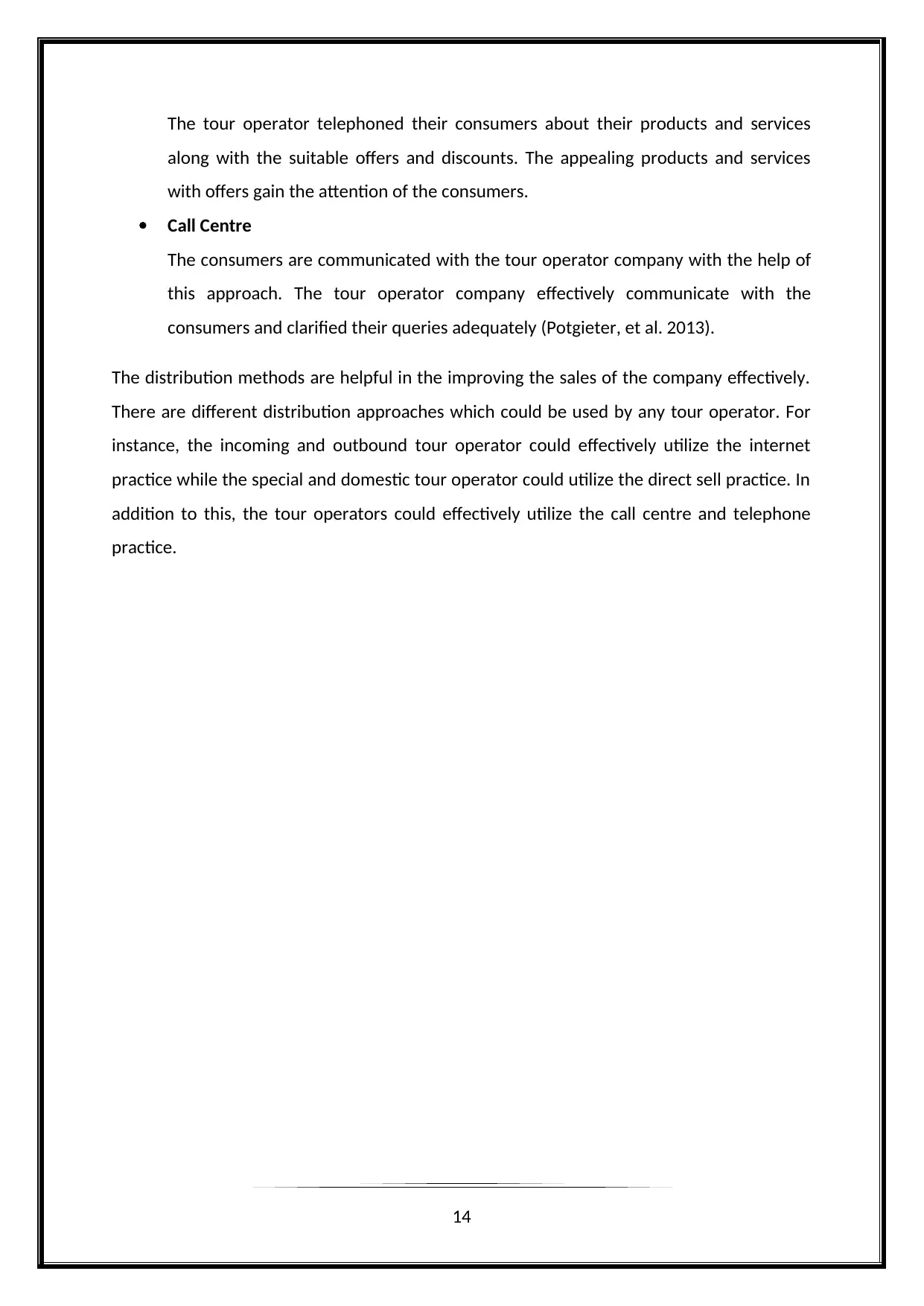
The tour operator telephoned their consumers about their products and services
along with the suitable offers and discounts. The appealing products and services
with offers gain the attention of the consumers.
Call Centre
The consumers are communicated with the tour operator company with the help of
this approach. The tour operator company effectively communicate with the
consumers and clarified their queries adequately (Potgieter, et al. 2013).
The distribution methods are helpful in the improving the sales of the company effectively.
There are different distribution approaches which could be used by any tour operator. For
instance, the incoming and outbound tour operator could effectively utilize the internet
practice while the special and domestic tour operator could utilize the direct sell practice. In
addition to this, the tour operators could effectively utilize the call centre and telephone
practice.
14
along with the suitable offers and discounts. The appealing products and services
with offers gain the attention of the consumers.
Call Centre
The consumers are communicated with the tour operator company with the help of
this approach. The tour operator company effectively communicate with the
consumers and clarified their queries adequately (Potgieter, et al. 2013).
The distribution methods are helpful in the improving the sales of the company effectively.
There are different distribution approaches which could be used by any tour operator. For
instance, the incoming and outbound tour operator could effectively utilize the internet
practice while the special and domestic tour operator could utilize the direct sell practice. In
addition to this, the tour operators could effectively utilize the call centre and telephone
practice.
14
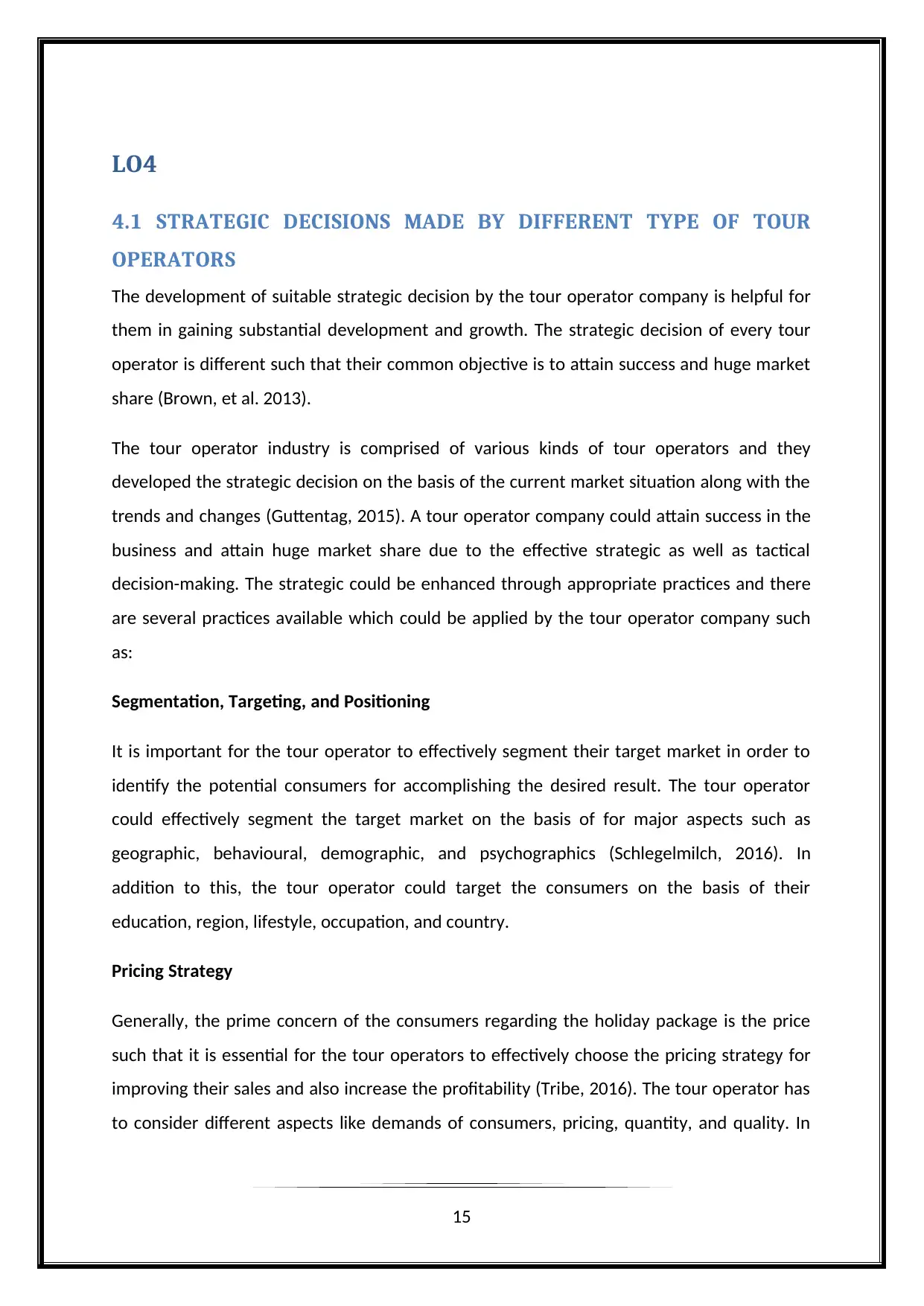
LO4
4.1 STRATEGIC DECISIONS MADE BY DIFFERENT TYPE OF TOUR
OPERATORS
The development of suitable strategic decision by the tour operator company is helpful for
them in gaining substantial development and growth. The strategic decision of every tour
operator is different such that their common objective is to attain success and huge market
share (Brown, et al. 2013).
The tour operator industry is comprised of various kinds of tour operators and they
developed the strategic decision on the basis of the current market situation along with the
trends and changes (Guttentag, 2015). A tour operator company could attain success in the
business and attain huge market share due to the effective strategic as well as tactical
decision-making. The strategic could be enhanced through appropriate practices and there
are several practices available which could be applied by the tour operator company such
as:
Segmentation, Targeting, and Positioning
It is important for the tour operator to effectively segment their target market in order to
identify the potential consumers for accomplishing the desired result. The tour operator
could effectively segment the target market on the basis of for major aspects such as
geographic, behavioural, demographic, and psychographics (Schlegelmilch, 2016). In
addition to this, the tour operator could target the consumers on the basis of their
education, region, lifestyle, occupation, and country.
Pricing Strategy
Generally, the prime concern of the consumers regarding the holiday package is the price
such that it is essential for the tour operators to effectively choose the pricing strategy for
improving their sales and also increase the profitability (Tribe, 2016). The tour operator has
to consider different aspects like demands of consumers, pricing, quantity, and quality. In
15
4.1 STRATEGIC DECISIONS MADE BY DIFFERENT TYPE OF TOUR
OPERATORS
The development of suitable strategic decision by the tour operator company is helpful for
them in gaining substantial development and growth. The strategic decision of every tour
operator is different such that their common objective is to attain success and huge market
share (Brown, et al. 2013).
The tour operator industry is comprised of various kinds of tour operators and they
developed the strategic decision on the basis of the current market situation along with the
trends and changes (Guttentag, 2015). A tour operator company could attain success in the
business and attain huge market share due to the effective strategic as well as tactical
decision-making. The strategic could be enhanced through appropriate practices and there
are several practices available which could be applied by the tour operator company such
as:
Segmentation, Targeting, and Positioning
It is important for the tour operator to effectively segment their target market in order to
identify the potential consumers for accomplishing the desired result. The tour operator
could effectively segment the target market on the basis of for major aspects such as
geographic, behavioural, demographic, and psychographics (Schlegelmilch, 2016). In
addition to this, the tour operator could target the consumers on the basis of their
education, region, lifestyle, occupation, and country.
Pricing Strategy
Generally, the prime concern of the consumers regarding the holiday package is the price
such that it is essential for the tour operators to effectively choose the pricing strategy for
improving their sales and also increase the profitability (Tribe, 2016). The tour operator has
to consider different aspects like demands of consumers, pricing, quantity, and quality. In
15
Secure Best Marks with AI Grader
Need help grading? Try our AI Grader for instant feedback on your assignments.
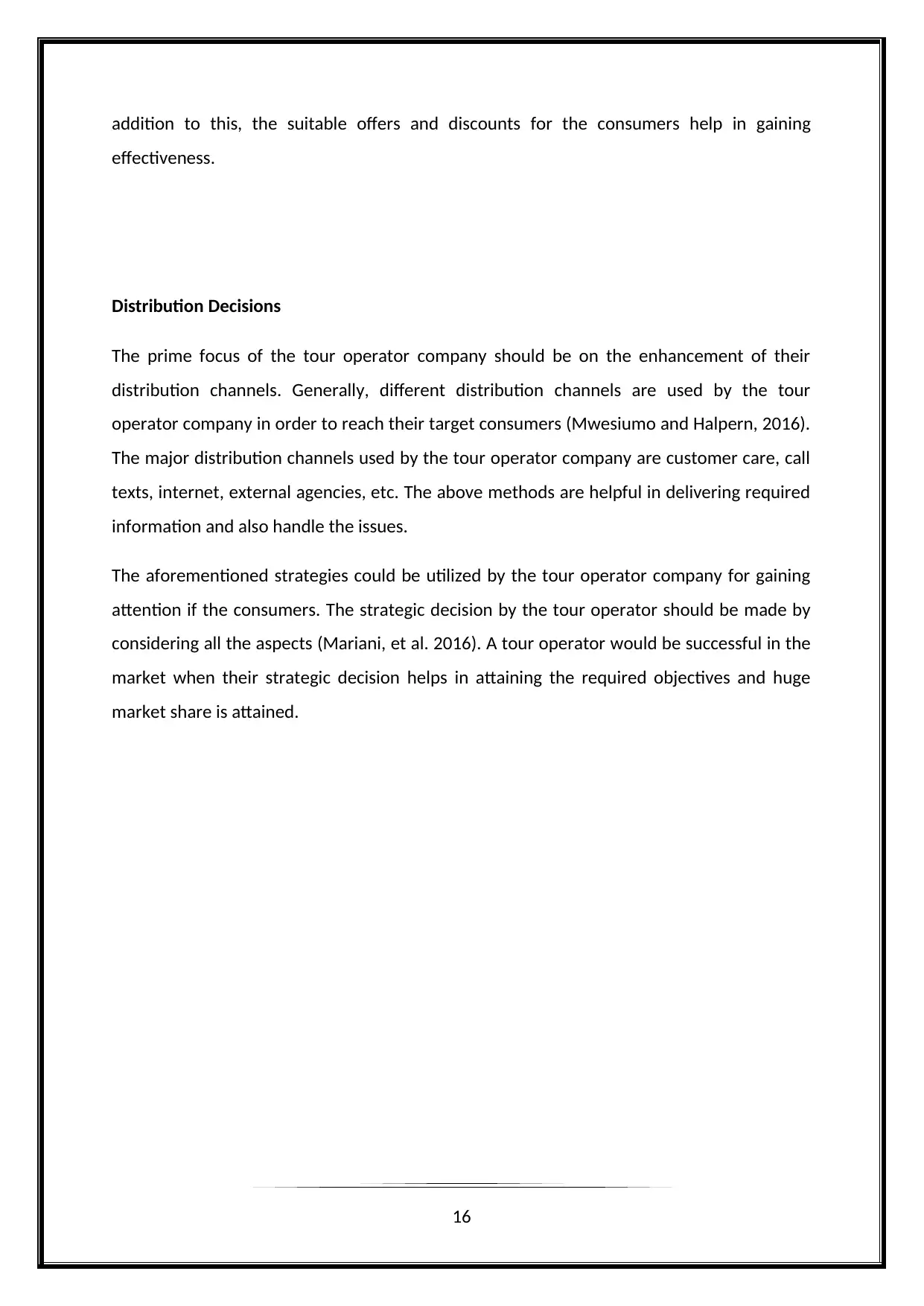
addition to this, the suitable offers and discounts for the consumers help in gaining
effectiveness.
Distribution Decisions
The prime focus of the tour operator company should be on the enhancement of their
distribution channels. Generally, different distribution channels are used by the tour
operator company in order to reach their target consumers (Mwesiumo and Halpern, 2016).
The major distribution channels used by the tour operator company are customer care, call
texts, internet, external agencies, etc. The above methods are helpful in delivering required
information and also handle the issues.
The aforementioned strategies could be utilized by the tour operator company for gaining
attention if the consumers. The strategic decision by the tour operator should be made by
considering all the aspects (Mariani, et al. 2016). A tour operator would be successful in the
market when their strategic decision helps in attaining the required objectives and huge
market share is attained.
16
effectiveness.
Distribution Decisions
The prime focus of the tour operator company should be on the enhancement of their
distribution channels. Generally, different distribution channels are used by the tour
operator company in order to reach their target consumers (Mwesiumo and Halpern, 2016).
The major distribution channels used by the tour operator company are customer care, call
texts, internet, external agencies, etc. The above methods are helpful in delivering required
information and also handle the issues.
The aforementioned strategies could be utilized by the tour operator company for gaining
attention if the consumers. The strategic decision by the tour operator should be made by
considering all the aspects (Mariani, et al. 2016). A tour operator would be successful in the
market when their strategic decision helps in attaining the required objectives and huge
market share is attained.
16
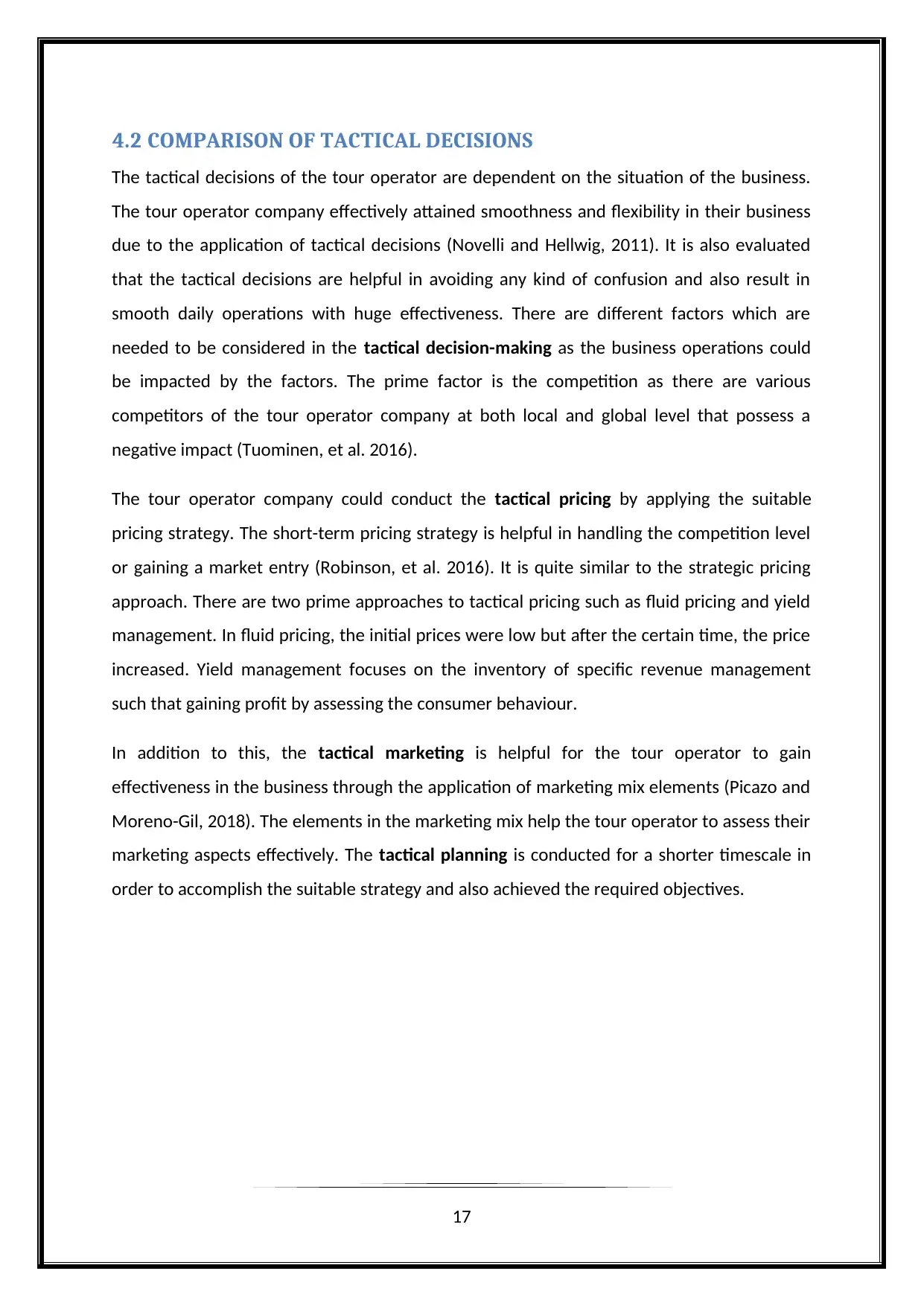
4.2 COMPARISON OF TACTICAL DECISIONS
The tactical decisions of the tour operator are dependent on the situation of the business.
The tour operator company effectively attained smoothness and flexibility in their business
due to the application of tactical decisions (Novelli and Hellwig, 2011). It is also evaluated
that the tactical decisions are helpful in avoiding any kind of confusion and also result in
smooth daily operations with huge effectiveness. There are different factors which are
needed to be considered in the tactical decision-making as the business operations could
be impacted by the factors. The prime factor is the competition as there are various
competitors of the tour operator company at both local and global level that possess a
negative impact (Tuominen, et al. 2016).
The tour operator company could conduct the tactical pricing by applying the suitable
pricing strategy. The short-term pricing strategy is helpful in handling the competition level
or gaining a market entry (Robinson, et al. 2016). It is quite similar to the strategic pricing
approach. There are two prime approaches to tactical pricing such as fluid pricing and yield
management. In fluid pricing, the initial prices were low but after the certain time, the price
increased. Yield management focuses on the inventory of specific revenue management
such that gaining profit by assessing the consumer behaviour.
In addition to this, the tactical marketing is helpful for the tour operator to gain
effectiveness in the business through the application of marketing mix elements (Picazo and
Moreno-Gil, 2018). The elements in the marketing mix help the tour operator to assess their
marketing aspects effectively. The tactical planning is conducted for a shorter timescale in
order to accomplish the suitable strategy and also achieved the required objectives.
17
The tactical decisions of the tour operator are dependent on the situation of the business.
The tour operator company effectively attained smoothness and flexibility in their business
due to the application of tactical decisions (Novelli and Hellwig, 2011). It is also evaluated
that the tactical decisions are helpful in avoiding any kind of confusion and also result in
smooth daily operations with huge effectiveness. There are different factors which are
needed to be considered in the tactical decision-making as the business operations could
be impacted by the factors. The prime factor is the competition as there are various
competitors of the tour operator company at both local and global level that possess a
negative impact (Tuominen, et al. 2016).
The tour operator company could conduct the tactical pricing by applying the suitable
pricing strategy. The short-term pricing strategy is helpful in handling the competition level
or gaining a market entry (Robinson, et al. 2016). It is quite similar to the strategic pricing
approach. There are two prime approaches to tactical pricing such as fluid pricing and yield
management. In fluid pricing, the initial prices were low but after the certain time, the price
increased. Yield management focuses on the inventory of specific revenue management
such that gaining profit by assessing the consumer behaviour.
In addition to this, the tactical marketing is helpful for the tour operator to gain
effectiveness in the business through the application of marketing mix elements (Picazo and
Moreno-Gil, 2018). The elements in the marketing mix help the tour operator to assess their
marketing aspects effectively. The tactical planning is conducted for a shorter timescale in
order to accomplish the suitable strategy and also achieved the required objectives.
17
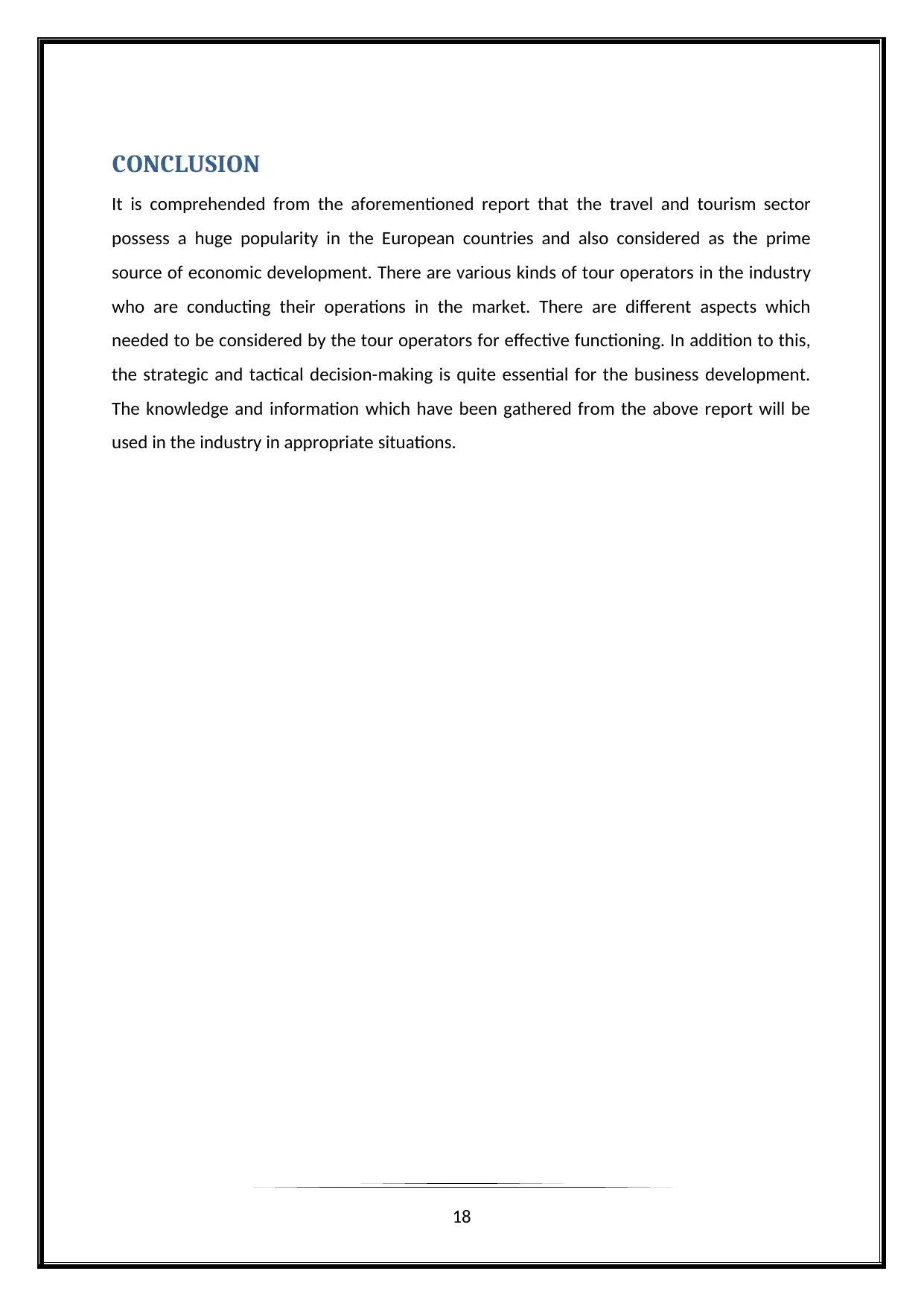
CONCLUSION
It is comprehended from the aforementioned report that the travel and tourism sector
possess a huge popularity in the European countries and also considered as the prime
source of economic development. There are various kinds of tour operators in the industry
who are conducting their operations in the market. There are different aspects which
needed to be considered by the tour operators for effective functioning. In addition to this,
the strategic and tactical decision-making is quite essential for the business development.
The knowledge and information which have been gathered from the above report will be
used in the industry in appropriate situations.
18
It is comprehended from the aforementioned report that the travel and tourism sector
possess a huge popularity in the European countries and also considered as the prime
source of economic development. There are various kinds of tour operators in the industry
who are conducting their operations in the market. There are different aspects which
needed to be considered by the tour operators for effective functioning. In addition to this,
the strategic and tactical decision-making is quite essential for the business development.
The knowledge and information which have been gathered from the above report will be
used in the industry in appropriate situations.
18
Paraphrase This Document
Need a fresh take? Get an instant paraphrase of this document with our AI Paraphraser
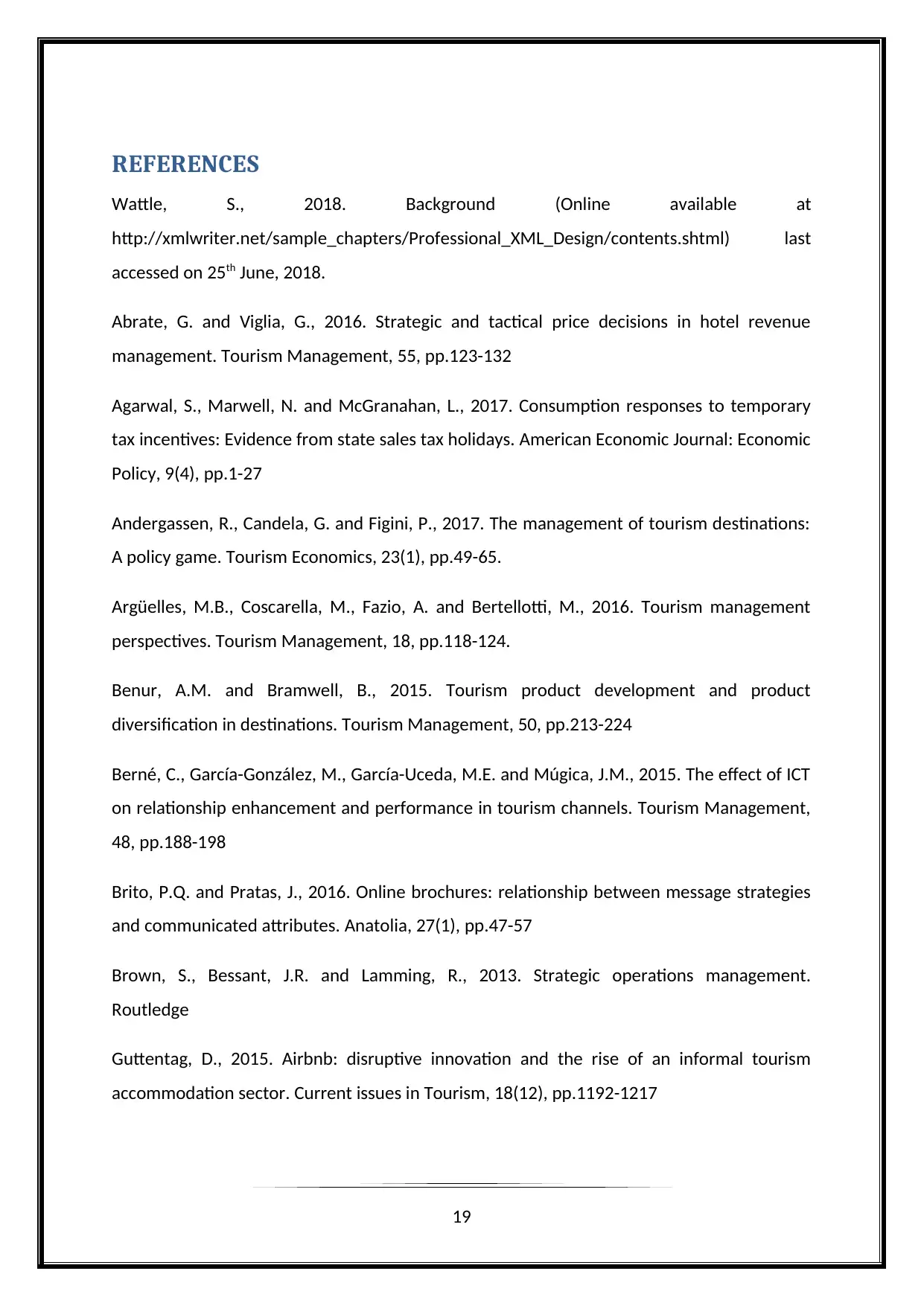
REFERENCES
Wattle, S., 2018. Background (Online available at
http://xmlwriter.net/sample_chapters/Professional_XML_Design/contents.shtml) last
accessed on 25th June, 2018.
Abrate, G. and Viglia, G., 2016. Strategic and tactical price decisions in hotel revenue
management. Tourism Management, 55, pp.123-132
Agarwal, S., Marwell, N. and McGranahan, L., 2017. Consumption responses to temporary
tax incentives: Evidence from state sales tax holidays. American Economic Journal: Economic
Policy, 9(4), pp.1-27
Andergassen, R., Candela, G. and Figini, P., 2017. The management of tourism destinations:
A policy game. Tourism Economics, 23(1), pp.49-65.
Argüelles, M.B., Coscarella, M., Fazio, A. and Bertellotti, M., 2016. Tourism management
perspectives. Tourism Management, 18, pp.118-124.
Benur, A.M. and Bramwell, B., 2015. Tourism product development and product
diversification in destinations. Tourism Management, 50, pp.213-224
Berné, C., García-González, M., García-Uceda, M.E. and Múgica, J.M., 2015. The effect of ICT
on relationship enhancement and performance in tourism channels. Tourism Management,
48, pp.188-198
Brito, P.Q. and Pratas, J., 2016. Online brochures: relationship between message strategies
and communicated attributes. Anatolia, 27(1), pp.47-57
Brown, S., Bessant, J.R. and Lamming, R., 2013. Strategic operations management.
Routledge
Guttentag, D., 2015. Airbnb: disruptive innovation and the rise of an informal tourism
accommodation sector. Current issues in Tourism, 18(12), pp.1192-1217
19
Wattle, S., 2018. Background (Online available at
http://xmlwriter.net/sample_chapters/Professional_XML_Design/contents.shtml) last
accessed on 25th June, 2018.
Abrate, G. and Viglia, G., 2016. Strategic and tactical price decisions in hotel revenue
management. Tourism Management, 55, pp.123-132
Agarwal, S., Marwell, N. and McGranahan, L., 2017. Consumption responses to temporary
tax incentives: Evidence from state sales tax holidays. American Economic Journal: Economic
Policy, 9(4), pp.1-27
Andergassen, R., Candela, G. and Figini, P., 2017. The management of tourism destinations:
A policy game. Tourism Economics, 23(1), pp.49-65.
Argüelles, M.B., Coscarella, M., Fazio, A. and Bertellotti, M., 2016. Tourism management
perspectives. Tourism Management, 18, pp.118-124.
Benur, A.M. and Bramwell, B., 2015. Tourism product development and product
diversification in destinations. Tourism Management, 50, pp.213-224
Berné, C., García-González, M., García-Uceda, M.E. and Múgica, J.M., 2015. The effect of ICT
on relationship enhancement and performance in tourism channels. Tourism Management,
48, pp.188-198
Brito, P.Q. and Pratas, J., 2016. Online brochures: relationship between message strategies
and communicated attributes. Anatolia, 27(1), pp.47-57
Brown, S., Bessant, J.R. and Lamming, R., 2013. Strategic operations management.
Routledge
Guttentag, D., 2015. Airbnb: disruptive innovation and the rise of an informal tourism
accommodation sector. Current issues in Tourism, 18(12), pp.1192-1217
19
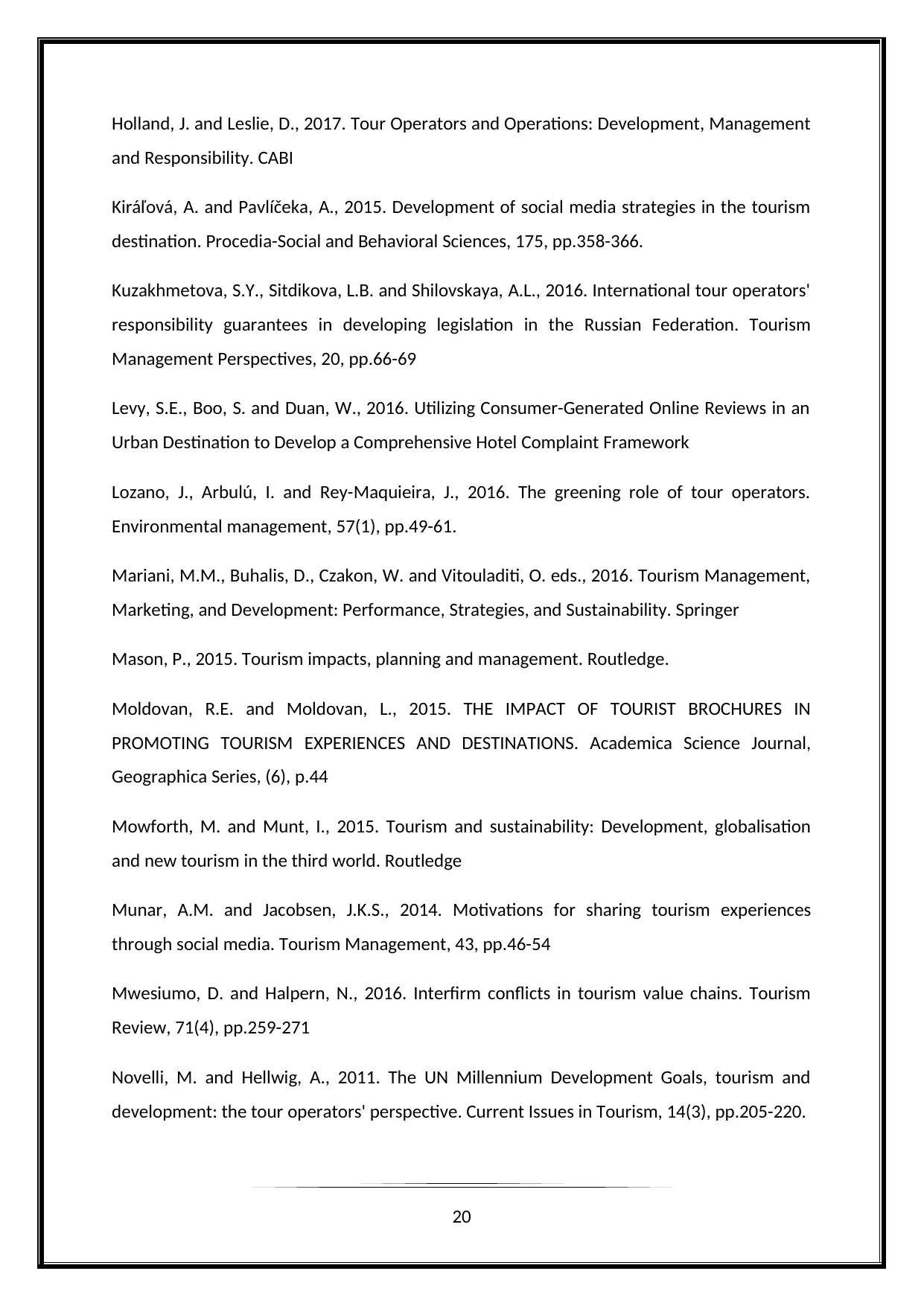
Holland, J. and Leslie, D., 2017. Tour Operators and Operations: Development, Management
and Responsibility. CABI
Kiráľová, A. and Pavlíčeka, A., 2015. Development of social media strategies in the tourism
destination. Procedia-Social and Behavioral Sciences, 175, pp.358-366.
Kuzakhmetova, S.Y., Sitdikova, L.B. and Shilovskaya, A.L., 2016. International tour operators'
responsibility guarantees in developing legislation in the Russian Federation. Tourism
Management Perspectives, 20, pp.66-69
Levy, S.E., Boo, S. and Duan, W., 2016. Utilizing Consumer-Generated Online Reviews in an
Urban Destination to Develop a Comprehensive Hotel Complaint Framework
Lozano, J., Arbulú, I. and Rey-Maquieira, J., 2016. The greening role of tour operators.
Environmental management, 57(1), pp.49-61.
Mariani, M.M., Buhalis, D., Czakon, W. and Vitouladiti, O. eds., 2016. Tourism Management,
Marketing, and Development: Performance, Strategies, and Sustainability. Springer
Mason, P., 2015. Tourism impacts, planning and management. Routledge.
Moldovan, R.E. and Moldovan, L., 2015. THE IMPACT OF TOURIST BROCHURES IN
PROMOTING TOURISM EXPERIENCES AND DESTINATIONS. Academica Science Journal,
Geographica Series, (6), p.44
Mowforth, M. and Munt, I., 2015. Tourism and sustainability: Development, globalisation
and new tourism in the third world. Routledge
Munar, A.M. and Jacobsen, J.K.S., 2014. Motivations for sharing tourism experiences
through social media. Tourism Management, 43, pp.46-54
Mwesiumo, D. and Halpern, N., 2016. Interfirm conflicts in tourism value chains. Tourism
Review, 71(4), pp.259-271
Novelli, M. and Hellwig, A., 2011. The UN Millennium Development Goals, tourism and
development: the tour operators' perspective. Current Issues in Tourism, 14(3), pp.205-220.
20
and Responsibility. CABI
Kiráľová, A. and Pavlíčeka, A., 2015. Development of social media strategies in the tourism
destination. Procedia-Social and Behavioral Sciences, 175, pp.358-366.
Kuzakhmetova, S.Y., Sitdikova, L.B. and Shilovskaya, A.L., 2016. International tour operators'
responsibility guarantees in developing legislation in the Russian Federation. Tourism
Management Perspectives, 20, pp.66-69
Levy, S.E., Boo, S. and Duan, W., 2016. Utilizing Consumer-Generated Online Reviews in an
Urban Destination to Develop a Comprehensive Hotel Complaint Framework
Lozano, J., Arbulú, I. and Rey-Maquieira, J., 2016. The greening role of tour operators.
Environmental management, 57(1), pp.49-61.
Mariani, M.M., Buhalis, D., Czakon, W. and Vitouladiti, O. eds., 2016. Tourism Management,
Marketing, and Development: Performance, Strategies, and Sustainability. Springer
Mason, P., 2015. Tourism impacts, planning and management. Routledge.
Moldovan, R.E. and Moldovan, L., 2015. THE IMPACT OF TOURIST BROCHURES IN
PROMOTING TOURISM EXPERIENCES AND DESTINATIONS. Academica Science Journal,
Geographica Series, (6), p.44
Mowforth, M. and Munt, I., 2015. Tourism and sustainability: Development, globalisation
and new tourism in the third world. Routledge
Munar, A.M. and Jacobsen, J.K.S., 2014. Motivations for sharing tourism experiences
through social media. Tourism Management, 43, pp.46-54
Mwesiumo, D. and Halpern, N., 2016. Interfirm conflicts in tourism value chains. Tourism
Review, 71(4), pp.259-271
Novelli, M. and Hellwig, A., 2011. The UN Millennium Development Goals, tourism and
development: the tour operators' perspective. Current Issues in Tourism, 14(3), pp.205-220.
20
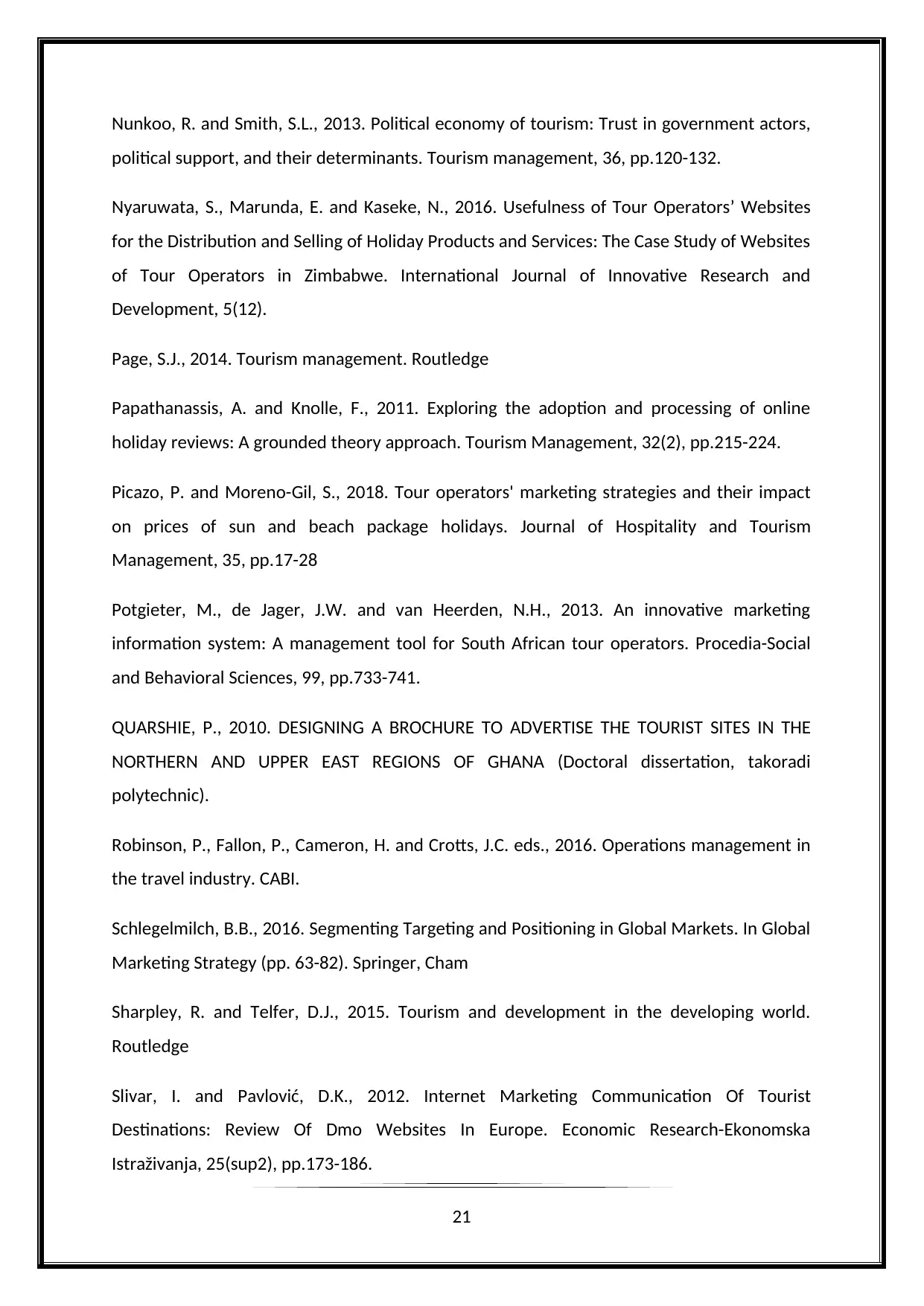
Nunkoo, R. and Smith, S.L., 2013. Political economy of tourism: Trust in government actors,
political support, and their determinants. Tourism management, 36, pp.120-132.
Nyaruwata, S., Marunda, E. and Kaseke, N., 2016. Usefulness of Tour Operators’ Websites
for the Distribution and Selling of Holiday Products and Services: The Case Study of Websites
of Tour Operators in Zimbabwe. International Journal of Innovative Research and
Development, 5(12).
Page, S.J., 2014. Tourism management. Routledge
Papathanassis, A. and Knolle, F., 2011. Exploring the adoption and processing of online
holiday reviews: A grounded theory approach. Tourism Management, 32(2), pp.215-224.
Picazo, P. and Moreno-Gil, S., 2018. Tour operators' marketing strategies and their impact
on prices of sun and beach package holidays. Journal of Hospitality and Tourism
Management, 35, pp.17-28
Potgieter, M., de Jager, J.W. and van Heerden, N.H., 2013. An innovative marketing
information system: A management tool for South African tour operators. Procedia-Social
and Behavioral Sciences, 99, pp.733-741.
QUARSHIE, P., 2010. DESIGNING A BROCHURE TO ADVERTISE THE TOURIST SITES IN THE
NORTHERN AND UPPER EAST REGIONS OF GHANA (Doctoral dissertation, takoradi
polytechnic).
Robinson, P., Fallon, P., Cameron, H. and Crotts, J.C. eds., 2016. Operations management in
the travel industry. CABI.
Schlegelmilch, B.B., 2016. Segmenting Targeting and Positioning in Global Markets. In Global
Marketing Strategy (pp. 63-82). Springer, Cham
Sharpley, R. and Telfer, D.J., 2015. Tourism and development in the developing world.
Routledge
Slivar, I. and Pavlović, D.K., 2012. Internet Marketing Communication Of Tourist
Destinations: Review Of Dmo Websites In Europe. Economic Research-Ekonomska
Istraživanja, 25(sup2), pp.173-186.
21
political support, and their determinants. Tourism management, 36, pp.120-132.
Nyaruwata, S., Marunda, E. and Kaseke, N., 2016. Usefulness of Tour Operators’ Websites
for the Distribution and Selling of Holiday Products and Services: The Case Study of Websites
of Tour Operators in Zimbabwe. International Journal of Innovative Research and
Development, 5(12).
Page, S.J., 2014. Tourism management. Routledge
Papathanassis, A. and Knolle, F., 2011. Exploring the adoption and processing of online
holiday reviews: A grounded theory approach. Tourism Management, 32(2), pp.215-224.
Picazo, P. and Moreno-Gil, S., 2018. Tour operators' marketing strategies and their impact
on prices of sun and beach package holidays. Journal of Hospitality and Tourism
Management, 35, pp.17-28
Potgieter, M., de Jager, J.W. and van Heerden, N.H., 2013. An innovative marketing
information system: A management tool for South African tour operators. Procedia-Social
and Behavioral Sciences, 99, pp.733-741.
QUARSHIE, P., 2010. DESIGNING A BROCHURE TO ADVERTISE THE TOURIST SITES IN THE
NORTHERN AND UPPER EAST REGIONS OF GHANA (Doctoral dissertation, takoradi
polytechnic).
Robinson, P., Fallon, P., Cameron, H. and Crotts, J.C. eds., 2016. Operations management in
the travel industry. CABI.
Schlegelmilch, B.B., 2016. Segmenting Targeting and Positioning in Global Markets. In Global
Marketing Strategy (pp. 63-82). Springer, Cham
Sharpley, R. and Telfer, D.J., 2015. Tourism and development in the developing world.
Routledge
Slivar, I. and Pavlović, D.K., 2012. Internet Marketing Communication Of Tourist
Destinations: Review Of Dmo Websites In Europe. Economic Research-Ekonomska
Istraživanja, 25(sup2), pp.173-186.
21
Secure Best Marks with AI Grader
Need help grading? Try our AI Grader for instant feedback on your assignments.
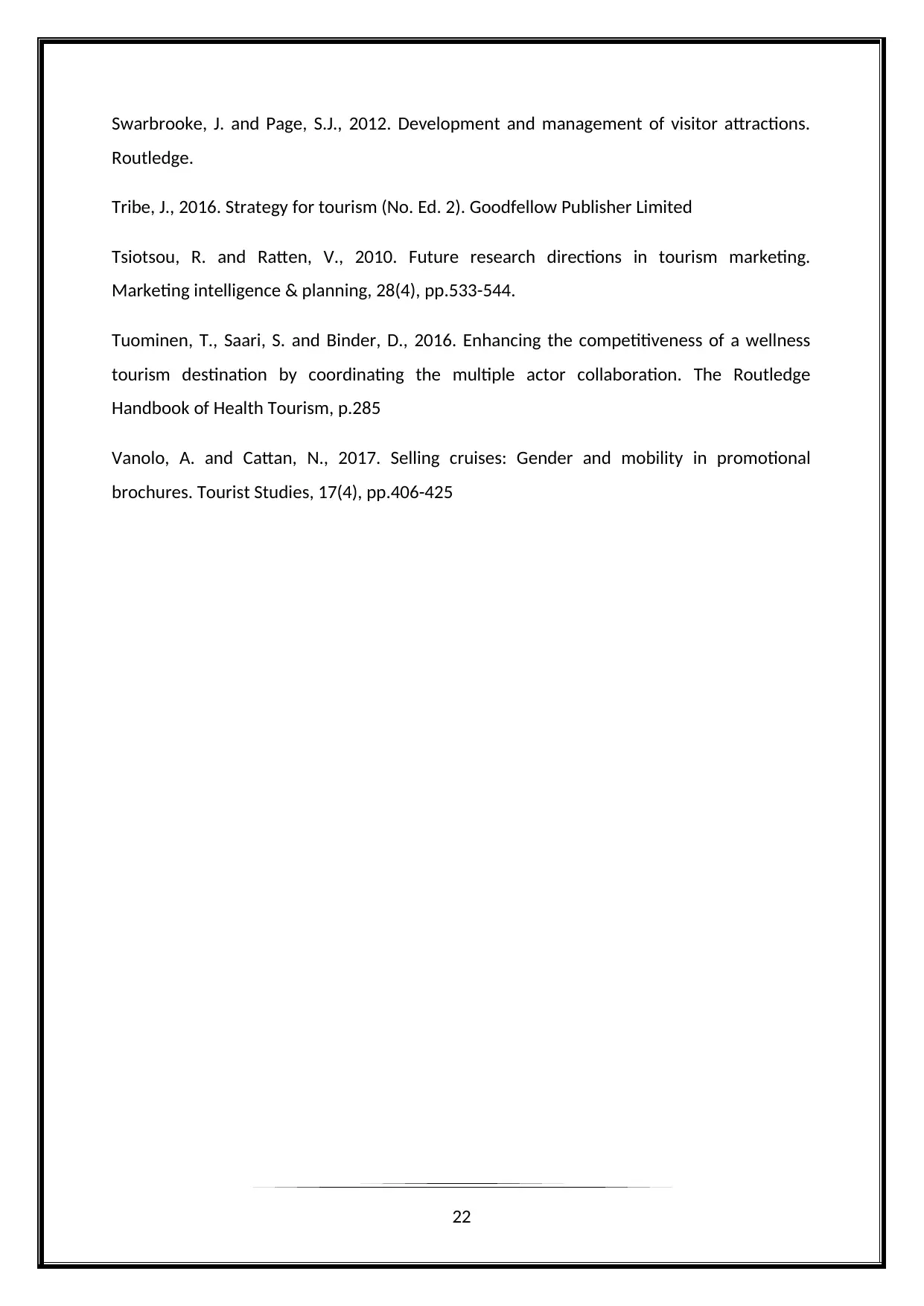
Swarbrooke, J. and Page, S.J., 2012. Development and management of visitor attractions.
Routledge.
Tribe, J., 2016. Strategy for tourism (No. Ed. 2). Goodfellow Publisher Limited
Tsiotsou, R. and Ratten, V., 2010. Future research directions in tourism marketing.
Marketing intelligence & planning, 28(4), pp.533-544.
Tuominen, T., Saari, S. and Binder, D., 2016. Enhancing the competitiveness of a wellness
tourism destination by coordinating the multiple actor collaboration. The Routledge
Handbook of Health Tourism, p.285
Vanolo, A. and Cattan, N., 2017. Selling cruises: Gender and mobility in promotional
brochures. Tourist Studies, 17(4), pp.406-425
22
Routledge.
Tribe, J., 2016. Strategy for tourism (No. Ed. 2). Goodfellow Publisher Limited
Tsiotsou, R. and Ratten, V., 2010. Future research directions in tourism marketing.
Marketing intelligence & planning, 28(4), pp.533-544.
Tuominen, T., Saari, S. and Binder, D., 2016. Enhancing the competitiveness of a wellness
tourism destination by coordinating the multiple actor collaboration. The Routledge
Handbook of Health Tourism, p.285
Vanolo, A. and Cattan, N., 2017. Selling cruises: Gender and mobility in promotional
brochures. Tourist Studies, 17(4), pp.406-425
22
1 out of 23
Related Documents
Your All-in-One AI-Powered Toolkit for Academic Success.
+13062052269
info@desklib.com
Available 24*7 on WhatsApp / Email
![[object Object]](/_next/static/media/star-bottom.7253800d.svg)
Unlock your academic potential
© 2024 | Zucol Services PVT LTD | All rights reserved.





